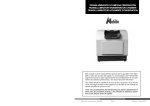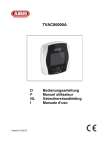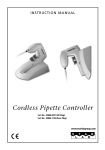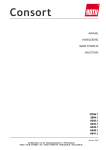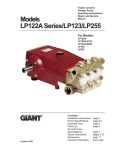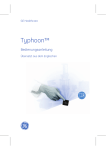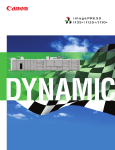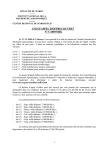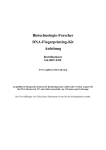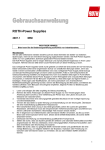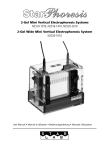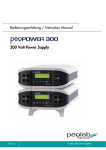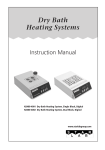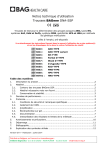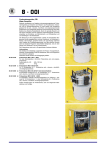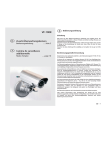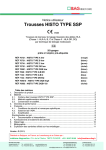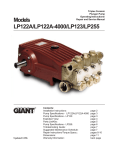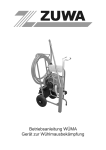Download wide & wide long horizontal manual spreads.qxp
Transcript
Wide Mini Gel Horizontal Electrophoresis System N2023-1410 Long Gel Horizontal Electrophoresis Systems N2113-2510 N2120-2510 Wide Long Gel Horizontal Electrophoresis Systems N2123-2510 N2123-4010 User Manual • Manuel d’utilisation • Bedienungsanleitung • Manuale Utilizzatore English Français Deutsch Italiano 2 13 24 36 – – – – 12 23 35 46 ENGLISH StarPhoresis Wide Mini Gel Horizontal Systems Catalogue No. N2023-1410 StarPhoresis Long Gel Horizontal Systems Catalogue Nos. N2113-2510, N2120-2510 StarPhoresis Wide Long Gel Horizontal Systems Catalogue Nos. N2123-2510, N2123-4010 Please read the entire User Manual before operating this unit. These units are capable of delivering potentially lethal voltage when connected to a power supply and should be operated only by qualified and technically trained personnel. Warranty Please check that the unit has been received complete and undamaged. Refer to the illustration below and to TABLE A to check that all components are present. Save all packaging and documents until you have thoroughly inspected your shipment; if you find that your order is incorrect or damaged please call STARLAB for instructions for its return. This warranty is valid for 36 months, but only if the product has been used and cared for according to this User Manual. No liability is accepted for loss or damage arising from incorrect use. The liability is limited to the repair or replacement of the unit, or a refund of the purchase price, at STARLAB’s option. STARLAB is not liable for any consequential damages. We refer to our general terms for sale. STARLAB reserves the right to alter the specifications of the Electrophoresis Systems without prior notice. This will enable us to implement improvements as soon as they are available. StarPhoresis Horizontal Electrophoresis System components: Combs Gel Tray Lid Buffer Chamber 2 StarPhoresis Wide Mini, Long & Wide Long Gel Horizontal Electrophoresis Systems TABLE A: System components included N2023-1410 N2113-2510 N2120-2510 N2123-2510 N2123-4010 Buffer Chamber (inc. levelling base) 1 1 1 1 1 Cover (w/power cords) 1 1 1 1 1 Gel Tray (gasketed) 1 1 1 1 1 Combs 4 3 3 4 4 TABLE OF CONTENTS I. ENVIRONMENTAL CONDITIONS FOR USE . . . . . . . . . . . . . . . . . . . . . . . .3 II. SAFETY PRECAUTIONS . . . . . . . . . . . . . . . . . . . . . . . . . . . . . . . . . . . . . . .4 III. INTRODUCTION IV. GENERAL CARE AND CLEANING . . . . . . . . . . . . . . . . . . . . . . . . . . . . . . .5 V. SPECIFICATIONS VI. CASTING THE GEL . . . . . . . . . . . . . . . . . . . . . . . . . . . . . . . . . . . . . . . . . . .6 . . . . . . . . . . . . . . . . . . . . . . . . . . . . . . . . . . . . . . . . . . . .4 . . . . . . . . . . . . . . . . . . . . . . . . . . . . . . . . . . . . . . . . . . . .6 VII. OPERATION . . . . . . . . . . . . . . . . . . . . . . . . . . . . . . . . . . . . . . . . . . . . . . . .7 VIII. VISUALISATION . . . . . . . . . . . . . . . . . . . . . . . . . . . . . . . . . . . . . . . . . . . . .8 IX. TROUBLESHOOTING . . . . . . . . . . . . . . . . . . . . . . . . . . . . . . . . . . . . . . . . .8 X. COMB SPECIFICATIONS XI. ACCESSORIES . . . . . . . . . . . . . . . . . . . . . . . . . . . . . . . . . . . . . .9 . . . . . . . . . . . . . . . . . . . . . . . . . . . . . . . . . . . . . . . . . . . . .12 I. ENVIRONMENTAL CONDITIONS FOR USE • This unit is intended for indoor use only. • This unit can be operated safely at an altitude of 2,000m. • The normal operating temperature range is between 4ºC and 65ºC. • Maximum relative humidity 80% for temperatures up to 31ºC, decreasing linearly to 50%, relative humidity at 40ºC. StarPhoresis Wide Mini, Long & Wide Long Gel Horizontal Electrophoresis Systems 3 II. SAFETY PRECAUTIONS Please read the User Manual carefully before using the STARLAB Horizontal Electrophoresis Unit. This manual contains important operating and safety information. STARLAB’s electrophoresis units are designed to perform flawlessly for years in the most demanding laboratories. Please take the time to read this manual so you understand the safety and operating instructions to ensure the successful use of the unit. Alterations could cause serious injury to the user or the system. Power to the unit is supplied by an external power supply. The power supply must meet safety standards for IEC 1010-1 regulations and must be ground isolated and incorporate a no-load detecting circuit. Power is supplied to the gel through the cover of the system providing a safety interlock to the user. Users should not attempt to operate this unit without the safety inter-locked cover in place. • To avoid the risk of personal shock always disconnect the unit from the power supply before: a) removing cover , b) moving the unit or, c) adding running buffer. • Running conditions should not exceed the maximum operating voltage or current. • DO NOT fill the buffer chamber with running buffer above the maximum fill line. • Use this apparatus only for its intended purpose and as described in this manual. • Do not use the product if the power cords are damaged or if its surfaces are cracked. • Do not operate electrophoresis units in metal trays. CAUTION: During electrophoresis very low quantities of various gases are produced at the electrodes. The type of gas produced depends on the composition of the buffer employed. To disperse these gases make sure that the unit is run in a well-ventilated area. III. INTRODUCTION Thank you for purchasing a StarPhoresis Long Gel Horizontal Electrophoresis System. Our systems have increased capacity and are ideally suited for the analysis of up to 600 sample sets of DNA or RNA, or labs that need to clearly resolve samples containing a large number of fragments. All units incorporate our tape-free gel casting to expediate gel preparation. The UV transparent gel trays are available with a variety of comb slot configurations. Combs are available in 1.0mm and 1.5mm thicknesses, as well as a variety of tooth configurations to accommodate varying numbers of samples and sample volumes. Outstanding features ensure trouble-free use • Robust, acrylic construction stands up to daily usage without breakage, warping or leakage. • All of STARLAB’s Long Horizontal Electrophoresis Systems are hand-made to provide unmatched durability for years of daily use. • Systems meet or exceed all safety requirements for the IEC 1010-1 Standards. • Gel trays accommodate gasketed end gates, allowing casting of gels in the unit without tape, dams or external casting stands. 4 StarPhoresis Wide Mini, Long & Wide Long Gel Horizontal Electrophoresis Systems IV. GENERAL CARE AND CLEANING WARNING! Acrylic is not resistant to aromatic or halogenated hydrocarbons, ketones or esters. Organic solvents cause acrylic to “craze” or crack. Do not use ethanol or other organic solvents to clean the unit. • Do not autoclave, bake or microwave the unit. • Before using, clean and dry the unit. Clean with DISTILLED WATER ONLY; dry parts with clean, lint-free lab wipes or, preferably, air dry. Use care when cleaning or drying the unit near the platinum wire. The connectors should be clean and dry before usage or storage. • Do not use abrasive creams or scourers. • Do not use cleaning brushes in the electrode area. • A thorough rinse with distilled water is all that is generally required to clean the unit after use. A mild detergent may also be used. Acrylic can also be exposed to a mild bleach solution (10:1). In addition RNAse removal products are also safe for acrylic. Gel tray All STARLAB gel trays are made from UV transmissible acrylic, which allows a stained agarose gel to be viewed directly in the tray on a transilluminator. NOTE: care should be taken to avoid pouring freshly melted agarose directly into the gel tray, as this may damage the tray. Always allow agarose to cool to 60oC before pouring into the tray. Combs Combs are available in thicknesses of 1.0mm and 1.5mm. Comb spines are acrylic and the teeth are polycarbonate. Combs designated “Microtitre” are compatible for use with a multi-channel pipettor. Each comb is labelled with its thickness, number of teeth and catalogue number. Please see Chapter 10, Comb Specifications, for details of the combs available for each device. Buffer Tank The buffer tank holds the buffer and gel tray. The larger systems are manufactured with a three point levelling base. The need to cast and run larger gels on a level surface is very important for consisten reproducible results. Current is passed from the power supply through the leads to the cover connectors, through the platinum wires and into the buffer and from there into the gel. The cover incorporates safety rings that prevent human contact with the electrode connections to prevent electrical shock if the power supply is not turned off prior to removing the lid. Users should not attempt to operate the system without the lid in place. The electrode banana plugs are colour-coded red and black to ensure that the gel is placed in the correct orientation in the tank [almost all electrophoretic separations of biomolecules run from the black electrode (negative) to the red electrode (positive)]. The connection between the banana plug and the electrode wire is sealed with a proprietary composite that eliminates corrosion of the connection. The electrode wires are 0.254mm platinum and are secured to the inner walls of the tank. Care should be taken not to damage the electrodes when cleaning the unit. StarPhoresis Wide Mini, Long & Wide Long Gel Horizontal Electrophoresis Systems 5 V. SPECIFICATIONS TABLE B: General specifications N2023-1410 N2113-2510 N2120-2510 N2123-2510 N2123-4010 23.5 x 14cm 13 x 25cm 20 x 25cm 23.5 x 25cm 23.5 x 40cm System dimensions (w x l x h) 26 x 29 x 10cm 21.5 x 37.5 x 10.5cm 29 x 37.5 x 10.5cm 32 x 37.5 x 10.5cm 32 x 53 x 10.5cm Tray configuration 4 comb slots 6 comb slots 6 comb slots Gel dimensions (w x l) UVT gel tray Agarose capacity (0.5cm T) Runs 1, 2, 3, or 4 Runs 1, 2, 3 or 4 Runs 1, 2, 3 or 4 equal length gels equal length gels equal length gels 161ml 163ml 14 comb slots 12 comb slots Runs 1, 2, 3, 4, 5 or 10 equal length gels Runs 1, 2, 3, 4, 6 or 12 equal length gels 294ml 460ml 250ml Max. buffer volume 1000ml 1600ml 2300ml 3000ml 4500ml Buffer exchange ports optional optional optional optional yes Max. sample capacity 200 112 168 500 600 Max. sample run, full length 50 28 42 50 50 Comb thickness Comb specifications Safety lid with attached power cords 1.5mm, plus optional 1.0mm 4 x MT50 teeth, 1.5mm thickness 1 12, 16 & 20 16, 24 & 36 2 x MT25 & 2 x MT25 & teeth, teeth, 2 x MT50 teeth, 2 x MT50 teeth, 1.5mm thickness 1.5mm thickness 1.5mm thickness 1.5mm thickness 1 1 1 1 VI. CASTING THE GEL 1. Remove the lid from the gel box by holding the front of the buffer chamber with one hand and pulling the lid off by holding the centre of the back of the lid. The cover is attached to the back of the unit at the connection of the power cords to the banana plugs located on the unit. 2. To cast gels using the StarPhoresis gel tray, place the gel tray into the chamber making sure the gel tray rests level and is centred on the platform of the buffer chamber. Slide the gasketed end gates into the outermost grooves on either side of the gel tray. The end gates should be inserted tightly into the grooves with the gasket side facing out. 3. The larger systems are manufactured with a three-point levelling base. The need to cast and run larger gels on a level surface is very important for consistent reproducible results. Level the unit using the two thumb screws on the front of the base by slowly turning one thumb screw at a time, lining up the bubble in the level with the centre circle. 4. Prepare agarose as described in your individual application. 5. IMPORTANT: to avoid damage to UVT tray, always cool agarose to 60°C before pouring into tray. Any bubbles that form while pouring may be popped with a small glass pipette or the edge of the comb. Place combs into the comb slots on the gel tray being careful not to create bubbles along the teeth of the comb. If the entire gel length is required for separation, place one comb in the first comb slot on the tray. To separate more samples on one gel, use both comb slots on the tray. Allow gel to solidify for 30 minutes. 6 StarPhoresis Wide Mini, Long & Wide Long Gel Horizontal Electrophoresis Systems VII. OPERATION 1. Once the agarose has solidified, carefully remove the end gates to expose the open ends of the agarose to the buffer. Be sure the gel tray is placed in the proper orientation; the first comb should be closest to the cathode (black) electrode. The banana plugs have been sealed against corrosion with colour-coded sealant to ensure proper orientation. NOTE: If a high percentage agarose gel is cast it may be difficult to remove the casting comb from the tray. If resistance is felt when removing the casting comb, place the gel tray into the buffer tank and add buffer before removing the casting comb. 2. Pour the buffer into the tank. The level of buffer should cover the gel by at least 2-3mm (see Table B: General specifications for buffer volume guidelines). A fill line is located on the outside wall of the tank for easy reference. Too little buffer may cause the gel to dry out during the run, while excess buffer may slow DNA migration in the gel. 3. Load your samples on the gel. To load samples, angle the pipette tip into the well and slowly underlay sample into the well. Take care not to push pipette tip through the bottom of the sample well as this will result in significant well-to-well leakage of samples 4. Slide the cover onto the electrophoresis buffer tank, insuring complete connection of the tank’s banana plugs to the female connector ends of the power cords that are fixed to the cover. The cover acts as a safety inter-lock to prevent accidental shock during operation. 5. Attach the power cords to the power supply. Turn on the power supply and set to the appropriate voltage level and begin electrophoresis. Recommended running conditions are 5 volts/cm of inter-electrode distance, see TABLE C below. TABLE C: Recommended run conditions Distance between electrodes Max. Voltage N2023-1410 22cm (110V) 200V N2113-2510 34.3cm (171.5V) 200V N2120-2510 34.3cm (171.5V) 200V N2123-2510 34.3cm (171.5V) 200V N2123-4010 49cm (recommended 200V) 200V Model 6. Run the gel for the appropriate amount of time for the specific sample being analysed or until the dye front has migrated to approximately 5mm from the end of the gel. Turn off power supply and detach the power cords. Slide the cover back to remove. Lift the gel tray out of the buffer tank and proceed with visualisation. 7. It is important to rinse the tank with distilled water after every use in order to keep it clean. It is recommended to allow the tank to air dry, rather than drying with a wipe or towel, to avoid damage to the electrode wires. StarPhoresis Wide Mini, Long & Wide Long Gel Horizontal Electrophoresis Systems 7 VIII. VISUALISATION Stain the gel with ethidium bromide solution or other suitable stain for agarose gels. Note: Ethidium bromide is a mutagen and can cause serious skin and eye irritation. STARLAB recommends wearing its Microflex® FreeformTM gloves, and safety glasses, when handling. After the staining process gel may be viewed using a transilluminator. The gel tray is made of UV transmissible acrylic and, therefore, may be placed directly on the transilluminator to view the gel. IX. TROUBLESHOOTING Many factors may affect the quality of gel preparations. For example, preparation of gel and sample buffers, gel casting and tank assembly and/or run conditions. Reading and following the instructions in this user manual can solve most problems. Some of those most commonly experienced problems, along with suggestions for solving them, are listed below: Problem: COMBS WELL GET DAMAGED WHEN COMB IS REMOVED • Always allow the gel to solidify completely before moving the gel tray or the unit, and before removing the comb. Gently rock the comb back and forth to loosen the comb — the rocking helps to avoid suction as the comb is removed. • If a high percentage agarose gel is cast if may be difficult to remove the casting comb, place the gel tray into the buffer tank and add running buffer before removing the casting comb. Problem: SAMPLES DO NOT BAND SHARPLY & APPEAR DIFFUSED IN THE GEL BEFORE RUNNING • Gels should be allowed to solidify completely. For standard agarose this would be approx. 30 mins. • If STARLAB low-melt agarose is used it may be necessary to completely solidify gels at a cooler temperature in the refrigerator or cold room. • Gels should be submerged in 3–5mm of buffer to avoid gel drying out, but excess buffer > 5mm can cause decreased DNA mobility and band distortion. Problem: BANDS ARE NOT SHARP, CLEAR AND EVEN • Always follow the proper procedure for preparing the agarose according to the manufacturer’s instructions. • When preparing the agarose, be sure all the agarose powder is in solution before heating. Swirl occasionally while heating to melt and mix completely. Problem: GEL SMILING • Gel may be uneven. Be sure to pour gel on a level surface. • Voltage may be too high. Lower voltage setting on power supply. See TABLE C. Problem: NO MIGRATION • No power is contacting the gel. Be sure all contacts are made between the power supply and the electrophoresis tank. • Check buffer preparation to be sure the proper ionic strength buffer was prepared. 8 StarPhoresis Wide Mini, Long & Wide Long Gel Horizontal Electrophoresis Systems • Check integrity of electrodes to be sure no breakage has occurred. Any breaks in the electrode will cause slow migration or none at all. If a break is found contact STARLAB. • To test the unit, fill the tank with running buffer and attach to power supply without the gel tray and gel in the tank. The platinum wire electrodes will produce small bubbles as the current passes through. If a complete circuit does not exist there will be few or no bubbles. Problem: SLOW MIGRATION • Check buffer preparation to be sure the proper ionic strength buffer was prepared. • Voltage too low, increase voltage, see Instructions for proper running conditions. • Check integrity of electrodes to be sure no breakage has occurred. Any breaks in the electrode will cause slow migration or none at all. If a break is found contact STARLAB. Problem: GEL SEEMS TO RUN SLOWER THAN USUAL RUNNING CONDITIONS • The volume of running buffer used to submerge the gel should only be 3-5mm over the gel surface. Gel should be completely submerged to avoid the gel from drying out, which can smear the bands and possibly melt the gel due to overheating. • If excess buffer is added the mobility of the DNA decreases and band distortion may result. Problem: EXCESSIVE HEAT • Ionic strength of buffer is too high. Check buffer preparation to be sure the proper ionic strength buffer was prepared. • Voltage is too high, decrease the voltage; see TABLE C for proper running conditions. Problem: ONE SIDE OF GEL RUNNING SLOWER • Gel may be uneven. Be sure to pour gel on a level surface. • Check integrity of electrodes to be sure no breakage has occurred. Any breaks in the electrode may cause uneven migration or none at all. If a break is found contact STARLAB. Problem: NO BANDS VISIBLE • Be sure gel was placed in the electrophoresis tank in the proper orientation. If orientation or polarity is reversed, the samples will migrate off the gel. • If DNA marker was used and is present on the gel, check the integrity of the sample. • Shorten run time. Gel should be stopped when the dye front has migrated to approximately 5mm from the end of the gel. X. COMB SPECIFICATIONS NOTE: Well volumes are calculated assuming a 0.5cm thick gel. Since the comb placement leaves 0.2 cm of agarose under the sample well, a 0.5cm thick gel will have a sample well that is 0.3cm deep (a 1cm thick gel would leave a sample well depth of 0.8cm). Loading volume is calculated as: Thickness of Tooth x Width of Tooth x Depth of Sample (gel thickness – 0.2cm) x 75% StarPhoresis Wide Mini, Long & Wide Long Gel Horizontal Electrophoresis Systems 9 Combs for N2113-2510 STARLAB Comb Cat No. Well volume (μl) (13 x 25cm) Number of Teeth Thickness (mm) Width (mm) 0.5cm 0.75cm 1.0cm N2113-2538 8 1.0 13.9 31 57 83 N2113-2541 12 1.0 8.7 20 36 52 N2113-2535 16 1.0 6.1 14 25 37 N2113-2537 20 1.0 4.5 10 19 27 N2113-2539 24 1.0 3.5 8 14 21 14 1.0 7.2 16 30 43 N2113-2528 8 1.5 13.9 47 86 125 N2113-2532 12 1.5 8.7 29 54 78 N2113-2527 16 1.5 6.1 21 38 55 N2113-2530 20 1.5 4.5 15 28 41 N2113-2531 24 1.5 3.5 12 22 32 1 1.5 - - - - 14 1.5 7.2 24 45 65 2 1.5 117.3/4.7 396/17 725/29 1056/42 N2113-2067 Micrototre comb N2113-2590 Wall Comb N2113-2065 Microtitre Comb N2113-2050 Preparative Comb Combs for N2023-1410 (23.5 x 14cm) N2123-2510 (23.5 x 25cm) & N2123-4010 STARLAB Comb Cat No. Well volume (μl) (23.5 x 40cm) Number of Teeth Thickness (mm) Width (mm) 0.5cm 0.75cm 1.0cm Microtitre comb 25 1.0 7.2 16 30 43 N2023-1486 Microtitre comb 50 1.0 3.0 7 12 18 N2023-1464 Microtitre comb 25 1.5 7.2 24 45 65 N2023-1485 Microtitre comb 50 1.5 3.0 10 19 27 N2023-1490 1 1.5 - - - - N2023-1470 Wall comb 10 StarPhoresis Wide Mini, Long & Wide Long Gel Horizontal Electrophoresis Systems Combs for N2120-2510 STARLAB Comb Cat No. μl) Well volume (μ (20 x 25cm) Number of Teeth Thickness (mm) Width (mm) 0.5cm 0.75cm 1.0cm N2120-2538 8 1.0 22.7 51 94 136 N2120-2541 12 1.0 14.5 33 60 87 N2120-2535 16 1.0 10.4 23 43 62 N2120-2537 20 1.0 8.0 18 33 48 N2120-2539 24 1.0 6.4 14 26 38 N2120-2546 28 1.0 5.2 12 21 31 N2120-2547 32 1.0 4.3 10 18 26 N2120-2545 36 1.0 3.7 8 15 22 N2120-2553 18 1.0 7.2 16 30 43 21 1.0 7.2 16 30 43 42 1.0 2.7 6 11 16 N2120-2528 8 1.5 22.7 77 140 204 N2120-2532 12 1.5 14.5 49 90 131 N2120-2527 16 1.5 10.4 35 64 94 N2120-2530 20 1.5 8.0 27 50 72 N2120-2531 24 1.5 6.4 22 40 58 N2120-2543 28 1.5 5.2 18 32 47 N2120-2544 32 1.5 4.3 15 27 39 N2120-2542 36 1.5 3.7 13 23 33 N2120-2590 1 1.5 - - - - 18 1.5 7.2 24 45 65 21 1.5 7.2 24 45 65 42 1.5 2.7 9 17 24 2 1.5 187/4.7 631/16 1157/29 1683/42 Microtitre Comb N2120-2554 Microtitre Comb N2120-2555 Microtitre Comb Wall Comb N2120-2549 Microtitre Comb N2120-2551 Microtitre Comb N2120-2552 Microtitre Comb N2120-2550 Preparative Comb StarPhoresis Wide Mini, Long & Wide Long Gel Horizontal Electrophoresis Systems 11 XI. ACCESSORIES Accessories for N2023-1410 (23.5 x 14cm) N2023-1416 StarPhoresis Gel Tray 23.5 x 14cm gasketed, 4 comb slots, UVT N2113-2588 Replacement Gaskets for Gel Tray N2023-1416, Pack of 2 Accessories for N2113-2510 (13 x 25cm) N2113-2516 StarPhoresis Gel Tray 13 x 25cm gasketed, 6 comb slots, UVT N2113-2588 Replacement Gaskets for Gel Tray N2113-2516, Pack of 2 Accessories for N2120-2510 (20 x 25cm) N2120-2516 StarPhoresis Gel Tray 20 x 25cm gasketed, 6 comb slots, UVT N2120-2588 Replacement Gaskets for Gel Tray N2120-2516, Pack of 2 Accessories for N2123-2510 (23.5 x 25cm) N2123-2516 StarPhoresis Gel Tray 23.5 x 25cm gasketed, 14 comb slots, UVT N2123-4088 Replacement Gaskets for Gel Tray N2123-2516 and N2123-4016, Pack of 2 Accessories for N2123-4010 (23.5 x 40cm) N2123-4016 StarPhoresis Gel Tray 23.5 x 40cm gasketed, 12 comb slots, UVT N2123-4088 Replacement Gaskets for Gel Tray N2123-2516 and N2123-4016, Pack of 2 12 StarPhoresis Wide Mini, Long & Wide Long Gel Horizontal Electrophoresis Systems FRANÇAIS Systèmes d'électrophorèse horizontale pour mini gel large StarPhoresis Références: N2014-1010 Systèmes d'électrophorèse horizontale pour grand gel StarPhoresis Références: N2113-2510, N2120-2510 Systèmes d'électrophorèse horizontale pour très grand gel StarPhoresis Références: N2123-2510, N2123-4010 Il est conseillé de lire la totalité du manuel d'utilisation avant toute opération Ces articles sont des sources potentielles de tension électrique mortelle une fois alimentés en courant électrique et doivent par conséquent être utilisés par un personnel qualifié et formé. Garantie Assurez-vous que l'article reçu est complet et intact. Reportez-vous au TABLEAU A ci-contre et vérifiez que tous les éléments sont présents. Nous vous demandons de conserver tous les emballages et documents jusqu'à ce que vous ayez contrôlé votre colis. Si vous trouvez que votre commande est incorrecte ou endommagée, veuillez nous contacter pour connaître les modalités de retour. Cette garantie est valable 36 mois, à la condition que ce produit soit utilisé et entretenu en accord avec le manuel d'utilisation. Nous nous dégageons de toute responsabilité en cas de perte ou de dommage consécutif à une mauvaise utilisation. La responsabilité est limitée à la réparation, au remplacement de l'article ou à son remboursement selon la décision de STARLAB. STARLAB ne sera tenu responsable pour aucun dommage important. Nous vous prions de vous reporter aux conditions générales de vente. STARLAB se réserve le droit de modifier les spécifications des systèmes d’électrophorèse sans notice préalable. Ceci permettra d'effectuer des améliorations dès que celles-ci seront disponibles. Composition du système d’électrophorèse horizontale Peignes Plateau support de gel Couvercle Cuve Systèmes d’électrophorèse horizontale pour grand gel StarPhoresis 13 TABLEAU A: Eléments du système N2023-1410 N2113-2510 N2120-2510 N2123-2510 N2123-4010 Cuve (inclut la base à niveler) 1 1 1 1 1 Couvercle (avec jeu de cordons) 1 1 1 1 1 Plateau support de gel (avec joint d’étanchéité) 1 1 1 1 1 Peignes 4 3 3 4 4 SOMMAIRE I. CONDITIONS D’UTILISATION . . . . . . . . . . . . . . . . . . . . . . . . . . . . . . . .14 II. PRÉCAUTIONS D'EMPLOI . . . . . . . . . . . . . . . . . . . . . . . . . . . . . . . . . . .15 III. INTRODUCTION IV. ENTRETIEN ET NETTOYAGE . . . . . . . . . . . . . . . . . . . . . . . . . . . . . . . . .16 V. CARACTÉRISTIQUES . . . . . . . . . . . . . . . . . . . . . . . . . . . . . . . . . . . . . . .17 VI. COULAGE DU GEL VII. UTILISATION . . . . . . . . . . . . . . . . . . . . . . . . . . . . . . . . . . . . . . . . . . . . .18 VIII. VISUALISATION . . . . . . . . . . . . . . . . . . . . . . . . . . . . . . . . . . . . . . . . . . .19 IX. PROBLÈMES TECHNIQUES . . . . . . . . . . . . . . . . . . . . . . . . . . . . . . . . . .19 X. CARACTÉRISTIQUES DES PEIGNES . . . . . . . . . . . . . . . . . . . . . . . . . . . .21 XI. ACCESSOIRES . . . . . . . . . . . . . . . . . . . . . . . . . . . . . . . . . . . . . . . . . . . .23 . . . . . . . . . . . . . . . . . . . . . . . . . . . . . . . . . . . . . . . . . .15 . . . . . . . . . . . . . . . . . . . . . . . . . . . . . . . . . . . . . . . .17 I. CONDITIONS D'UTILISATION • Ce matériel est seulement prévu pour un usage d'intérieur. • Ce matériel peut être utilisé à une altitude de 2,000 m sans risque. • La plage de température d'utilisation normale est comprise entre 4ºC et 65ºC. • L'humidité relative maximale est de 80% pour des températures allant jusqu'à 31ºC, diminuant linéairement à 50%, humidité relative à 40ºC. 14 Systèmes d’électrophorèse horizontale pour grand gel StarPhoresis II. PRÉCAUTIONS D'EMPLOI Lisez le manuel d'utilisation attentivement avant d'utiliser l'unité d'électrophorèse horizontale. Ce manuel contient des informations importantes de sécurité et d'utilisation. Les unités d'électrophorèse de STARLAB sont conçues pour fonctionner parfaitement pendant des années dans les laboratoires les plus exigeants. Prenez le temps de lire le manuel pour vous assurer que vous comprenez les instructions de sécurité et d'utilisation afin d'assurer une utilisation correcte de l'unité. Une mauvaise utilisation pourrait soit blesser sérieusement l'utilisateur soit endommager le système. Le courant électrique est fourni à l'unité par une prise électrique externe. La prise électrique doit répondre aux normes de sécurité de régulation IEC 1010-1 et doit être isolée par la terre et incorporer un circuit détectant le non chargement. Le courant est apporté au gel à travers le couvercle du système muni d'un système de fermeture de sécurité pour l'utilisateur. Il est conseillé aux utilisateurs de ne pas utiliser ce matériel sans ce couvercle de sécurité. • Pour éviter tout risque d'électrocution débranchez toujours l'unité du courant électrique avant de a) enlever le couvercle b) bouger l'unité ou c) ajouter du tampon. • Les conditions d'utilisation ne doivent pas dépasser l'intensité ou le voltage maximum conseillés. • NE REMPLISSEZ PAS la cuve au dessus de la ligne de remplissage maximum . • N'utilisez ce matériel que dans le cadre de son champ d'application comme décrit dans le manuel. • N'utilisez pas ce matériel si les fils électriques sont endommagés ou si ses surfaces sont fissurées. • N'utilisez pas l'unité d'électrophorèse dans des plateaux métalliques. MISE EN GARDE: Pendant l'électrophorèse, de très faibles quantités de divers gaz sont produites au niveau des électrodes. Le type de gaz produit dépend de la composition du tampon utilisé. Pour disperser ces gaz, soyez sûr que l'unité fonctionne dans une zone bien ventilée. III. INTRODUCTION Merci de vous être procuré un Système d'Electrophorèse Horizontale pour grand gel STARLAB! Ces systèmes ont une plus grande capacité et peuvent être utilisés pour travailler jusqu’à 600 échantillons d’ADN ou d’ARN., ou pour les laboratoires qui ont besoin de purifier les échantillons qui contiennent beaucoup de fragments. Toutes nos cuves possèdent un support de gel pour couler les gels. Les plateaux de gel transparents aux UV sont disponibles avec plusieurs configurations de peignes. Les peignes sont disponibles avec 1,0 mm et 1,5 mm d'épaisseur. De plus, plusieurs configurations de dents permettent de s'adapter à une quantité variable d'échantillons et de volumes d'échantillons. Des caractéristiques remarquables assurent une utilisation aisée • La construction robuste en acrylique résiste à usage journalier sans cassure, fissure ou fuite. • Tous les systèmes d'électrophorèse horizontale de STARLAB sont fabriqués à la main, fournissant une durée de vie inégalée pour un usage quotidien et ceci pendant des années. • Les systèmes répondent et dépassent toutes les exigences de sécurité pour les standards IEC 1010-1. • Les bords du plateau support de gel sont pourvues de joint, qui permettent de couler les gels dans la cuve sans avoir recourt à des adhésifs ou un système de coulage externe. Systèmes d’électrophorèse horizontale pour grand gel StarPhoresis 15 IV. ENTRETIEN ET NETTOYAGE ATTENTION! L’acrylique n’est pas résistant aux hydrocarbures halogénés, cétones ou éthers. Les solvants organiques peuvent causer des craquements dans l’acrylique. N’utilisez pas d'éthanol ou d’autres solvants organiques pour nettoyer votre unité d’électrophorèse. Ne l’autoclavez pas, ne la mettez pas au four ni au micro-onde. • Avant utilisation, nettoyez et séchez votre système. Pour le nettoyage, utilisez exclusivement de l’eau distillée, séchez le système quand il est propre avec des essuyeurs ou en l'aérant. Faites attention quand vous nettoyez les parties proches du fil de platine. Les connections doivent être propres et sèches avant l'utilisation ou le stockage. • N'employez pas de crème abrasive ou d'éponge métallique • N'utilisez pas de brosse de nettoyage dans la région des électrodes • Un rinçage complet avec de l'eau distillée est généralement conseillé pour nettoyer l’unité après utilisation. Un détergent doux peut également être employé. L'acrylique peut également être nettoyé avec une solution diluée d’eau de javel (10:1). En outre, les produits d'enlèvement de RNase sont également sans danger pour l'acrylique. Plateau de gel Tous les plateaux de gel de STARLAB sont faits à partir d’acrylique transparent aux UV ce qui permet d'exploiter un gel d'agarose directement dans le plateau placé sur un transilluminateur. NOTE: Prenez soin d'évitez de verser l'agarose fraîchement fondu directement dans le plateau de gel, car ceci peut endommager le plateau. Attendez toujours que la température de l'agarose descende à 60°C avant de le verser dans le plateau. Peignes Les peignes sont disponibles avec des épaisseurs de 1,0 mm et 1,5 mm. Voir le chapitre 10: caractéristiques des peignes pour le détail des peignes disponibles pour chaque dispositif. Le dos du peigne est en acrylique et les dents sont en polycarbonate. Les peignes marqués "microtitration" sont compatibles avec l'utilisation d'une pipette multicanaux. Chaque peigne est marqué avec son épaisseur, son nombre de dents et son numéro dans le catalogue. Cuve La cuve maintient le plateau de tampon et le gel. Les systèmes plus larges ont été fabriqués avec un système permettant de faire le niveau grçace à 3 vis de nivelage. Afin d'obtenir des résultats reproductibles il est très important de couler et de faire migrer les gels sur une surface nivelée. Le courant passe de l'alimentation électrique aux connecteurs du couvercle par les fils de platine puis dans le tampon, et à partir de là dans le gel. Le couvercle incorpore des anneaux de sûreté qui empêchent tout contact éventuel entre vos doigts et les raccordements d'électrode, ceci afin d’empêcher les chocs électriques si l'alimentation n'est pas arrêtée avant d'enlever le couvercle. Ne pas essayer d'actionner le système si le couvercle n’est pas en place. Les prises d'électrode sont codées en rouge et noire pour s'assurer que le gel est placé dans l'orientation correcte dans la cuve [presque toutes les séparations électrophorétiques de biomolécules se font de l'électrode noire (négative) à l'électrode rouge (positive)]. Le raccordement entre la prise et le fil d'électrode est scellé avec un composé de breveté qui élimine la corrosion du raccordement. Les fils d'électrode sont en platine de 0,254 mm et sont fixés aux parois intérieures de la cuve. Faites attention de ne pas endommager les électrodes en nettoyant l'unité. 16 Systèmes d’électrophorèse horizontale pour grand gel StarPhoresis V. CARACTÉRISTIQUES TABLEAU B: Caractéristiques générales N2023-1410 N2113-2510 N2120-2510 N2123-2510 N2123-4010 Dimensions du gel (l x L) 23,5 x 14 cm 13 x 25 cm 20 x 25 cm 23,5 x 25 cm 23,5 x 40 cm Dimensions du système (l x L x h) 26 x 29 x 10 cm 21,5 x 37,5 x 10,5 cm 29 x 37,5 x 10,5 cm 32 x 37,5 x 10,5 cm 32 x 53 x 10,5 cm 4 fentes pour peigne 6 fentes pour peigne 6 fentes pour peigne 14 fentes pour peigne 12 fentes pour peigne Configuration des plateaux Peut recevoir 1, 2, Peut recevoir 1, 2, Peut recevoir 1, 2, Peut recevoir 1, 2, Peut recevoir 1, 2, 3 ou 4 gels de 3 ou 4 gels de 3 ou 4 gels de 3, 4, 5 ou 10 gels 3, 4, 6 ou 12 gels même longueur même longueur même longueur de même longueur de même longueur Plateau UVT Capacité en agarose (epaisseur 0.5cm) 161 ml 163 ml 250 ml 294 ml 460 ml Volume max du tampon 1000 ml 1600 ml 2300 ml 3000 ml 4500 ml Ports de circulation du tampon en option en option en option en option oui Capacité max d’échantillons 200 112 168 500 600 Nombre d’échantillons (gel longueur max) 50 28 42 50 50 Empaisseur du peigne Caractéristiques des peignes Courvercle avec cables 1,5mm, 1,0mm en option 12, 16 16, 24 2 x MT25 & 2 x MT25 & 4 x MT50 dents, & 20 dents, & 36 dents, 2 x MT50 dents, 2 x MT50 dents, épaisseur 1,5 mm épaisseur 1,5 mm épaisseur 1,5 mm épaisseur 1,5 mm épaisseur 1,5 mm 1 1 1 1 1 VI. COULAGE DU GEL 1. Oter le couvercle en tenant la cuve d’une main et en faisant glisser le couvercle (tenez le par l’arrière et au milieu du couvercle). Le couvercle est fixé au dos de la cuve grâce aux câbles d’alimentation qui se fichent dans la cuve. 2. Pour couler les gels en utilisant le plateau StarPhoresis, placer le plateau dans la cuve en vous assurant que celui-ci est bien posé au centre, sur la plateforme de la cuve. Glissez les deux plaques avec les joints dans les rainures de chaque côté du plateau. Les plaques doivent être insérées fermement dans les rainures, le joint vers l’extérieur. 3. Les systèmes les plus larges sont fabriqués avec un niveau à 3 points. Couler un gel sur une surface à niveau est très important afin d’obtenir des résultats reproductibles. Nivelez la cuve à l’aide des deux vis sur l’avant de la base, en tournant une vis à la fois: alignez la bulle au centre du cercle. 4. Préparer l'agarose comme décrit dans votre protocole. Systèmes d’électrophorèse horizontale pour grand gel StarPhoresis 17 5. IMPORTANT: pour éviter d'endommager le plateau UVT, descendre la température de l’agarose à 60°C . Les bulles présentes à la surface du gel encore liquide peuvent être enlevées en utilisant une pointe ou encore en passant le peigne sur la surface de manière à amener les bulles sur le bord. Placer les peignes dans les encoches prévues à cet effet, en faisant attention à la formation éventuelle de bulles le long des dents du peigne. Si les échantillons doivent migrer sur toute la longueur du gel, ne placer qu’un peigne à l’extrémité du gel. Deux peignes peuvent être placés sur un gel, divisant ainsi la longueur de migration par deux. Laisser 30 minutes pour la solidification du gel. VII. UTILISATION 1. Dès que le gel s’est solidifié, enlever les plaques pour exposer le gel au tampon. Faites attention à ce que le plateau soit bien orienté: le premier peigne doit être le plus près de la cathode (noire). Les prises sont protégées de la corrosion, et ont un code couleur pour éviter les erreurs d’orientation. NOTE: Si le pourcentage d’agarose du gel est élevé, il peut être difficile d’enlever le peigne du plateau. Si une résistance est sentie en enlevant le peigne, placer le plateau dans la cuve à électrophorèse et y ajouter du tampon avant d’enlever le peigne 2. Versez le tampon dans la cuve. Le niveau de celui-ci doit couvrir le gel d’au moins 2-3 mm (voir le Tableau B: Caractéristiques générales). Un repère se trouve à l’extérieur de la cuve comme indication. Une quantité insuffisante de tampon peut faire dessécher le gel, un excès peut ralentir la migration de l’ADN dans le gel. 3. Chargez vos échantillons sur le gel. Pour ceci, introduisez la pointe de pipette dans le puits en faisant attention de bien éjecter doucement l’échantillon dans le fond du puits. Faites attention toutefois à ne pas percer le fond, ce qui aurait comme conséquence la fuite de l’échantillon. 4. Glissez le couvercle sur la cuve d’électrophorèse, en s’assurant du bon branchement des prises. Le couvercle agit comme une sécurité en cas de choc accidentel lors du fonctionnement de l’appareil. 5. Branchez les cordons d’alimentation au générateur. Allumez le générateur, paramétrez les valeurs de tension. Commencez l’électrophorèse. Les paramètres recommandés sont de 5 volts/cm entre les deux électrodes, voir le tableau C: TABLEAU C: Conditions de migration recommandées Modèle 18 Distance entre électrodes Max. Voltage N2023-1410 22 cm (110 V) 200 V N2113-2510 34,3 cm (171.5 V) 200 V N2120-2510 34,3 cm (171.5 V) 200 V N2123-2510 34,3 cm (171.5 V) 200 V N2123-4010 49 cm (recommandé 200 V) 200 V Systèmes d’électrophorèse horizontale pour grand gel StarPhoresis 6. Laissez migrer le gel selon le temps indiqué par le protocole ou jusqu’à ce que le colorant arrive à 5mm de l’extrémité du gel. Stoppez le générateur et le débrancher. Enlevez le couvercle en le faisant glisser. Prenez le plateau avec des gants et procédez à sa visualisation. 7. Il est important de rincer la cuve après utilisation avec de l’eau distillée. Il est recommandé de laisser sécher la cuve, sans utiliser de chiffon ou de serviette, afin d’éviter d’endommager les fils d’électrode. VIII. VISUALISATION Colorez le gel avec la solution de bromure d'éthidium ou toute autre coloration appropriée pour des gels d'agarose. NOTE: Le bromure d'éthidium est un agent mutagène et peut causer une irritation sérieuse de la peau et des yeux. STARLAB recommande de porter ses gants Freeform®, ainsi que des lunettes de sécurité lors de toute utilisation. Après ce processus de révélation, le gel peut être regardé en utilisant un transilluminateur. Le plateau de gel est fait en acrylique transparent aux UV et peut, en conséquence, être placé directement sur le transilluminateur pour regarder le gel. IX. PROBLÈMES TECHNIQUES Beaucoup de facteurs peuvent affecter la qualité des préparations de gel. Par exemple, la préparation des tampons de gel et des échantillons, le choix du gel et le montage des plaques, les conditions de migration. La lecture et le suivi des instructions de cette manipulation peuvent résoudre la plupart des problèmes. Quelques suggestions aux problèmes les plus courants sont cités ci-dessous: Problème: LES PUITS ONT ÉTÉ ABÎMÉS QUAND ON A ENLEVÉ LE PEIGNE • Faites toujours attention à ce que le gel soit complètement solidifié avant de manipuler le plateau, la cuve ou d’enlever le peigne. Basculez doucement le peigne dans les deux sens pour le détacher – le basculement permet d’éviter le phénomène de succion quand le peigne est enlevé. • Si le pourcentage d’agarose du gel est élevé, il peut être difficile d’enlever le peigne du plateau. Si une résistance est sentie en enlevant le peigne, placer le plateau dans la cuve à électrophorèse et y ajouter du tampon avant d’enlever le peigne. Problème: LES ÉCHANTILLONS NE SE RÉUNISSENT PAS ET SEMBLENT ÊTRE DIFFUS DANS LE GEL AVANT LE DÉMARRAGE DE L’ÉLECTROPHORÈSE • Les gels doivent être complètement solidifiés. Pour l’agarose standard, il faut environ 30 minutes. • Si vous utilisez l’agarose low melt STARLAB, il est peut être nécessaire de faire solidifier l’agarose à une température plus basse: au réfrigérateur ou en chambre froide. • Les gels doivent être immergés dans 3 à 5mm de tampon afin d’éviter le dessèchement, mais un excès de tampon > 5mm peut ralentir la migration de l’ADN et entraîner une distorsion des bandes. Systèmes d’électrophorèse horizontale pour grand gel StarPhoresis 19 Problème: LES BANDES NE SONT PAS NETTES ET RÉGULIÈRES • Préparez toujours votre agarose en suivant les instructions du fabricant. • En préparant votre agarose, faites attention à ce que la totalité de l’agarose soit en solution avant de chauffer. Mélanger occasionnellement pendant le chauffage pour l’agarose fonde et se mélange entièrement Problème: GEL SOURIANT DIT « SMILING » • Le gel peut être inégal. Assurez vous que le système est posé sur une surface plane en versant le gel. • La tension peut être trop haute. Diminuez la tension d'utilisation. Voir le TABLEAU C: Conditions de migration recommandées. Problème: AUCUNE MIGRATION • Aucun courant électrique n'entre en contact avec le gel. Assurez vous que tous les contacts sont faits entre l'alimentation d'énergie et la cuve. • Vérifiez que la concentration ionique du tampon est appropriée. • Vérifiez l’intégrité des électrodes afin de vous assurer qu'aucun dommage ne s'est produit. Une électrode endommagée peut ralentir voire empêcher la migration. Si vous constatez que vos électrodes sont endommagées, contactez STARLAB. • Pour vérifier l’unité, remplir la cuve avec du tampon et connecter les câbles sans mettre le plateau et le gel. Le fil de platine des électrodes doit produire des petites bulles, signe du passage du courant. Si le circuit est ouvert, il ne devrait y avoir que peu ou pas de bulles. Problème: MIGRATION LENTE • Vérifiez que la concentration ionique du tampon est appropriée. • La tension peut être trop basse, augmentez la tension d'utilisation. Voir le TABLEAU C : Conditions de migration recommandées. • Vérifiez l’intégrité des électrodes afin de vous assurer qu'aucun dommage ne s'est produit. Une électrode endommagée peut ralentir voire empêcher la migration. Si vous constatez que vos électrodes sont endommagées, contactez STARLAB. Problème: LA MIGRATION SEMBLE PLUS LENTE DANS LES CONDITIONS HABITUELLES D’UTILISATION • La hauteur de tampon au dessus du gel ne doit pas excéder 3-5 mm. Le gel doit être entièrement immergé afin d’éviter le dessèchement, ce qui peut salir les bandes et faire fondre le gel à cause de la surchauffe. • Un excès de tampon peut ralentir la migration de l’ADN et entraîner une distorsion des bandes. Problème: CHALEUR EXCESSIVE • La concentration ionique du tampon est trop haute. Vérifiez la concentration ionique du tampon • La tension est trop haute, diminuez la tension; voir le tableau C: conditions de migration recommandées. 20 Systèmes d’électrophorèse horizontale pour grand gel StarPhoresis Problème: INÉGALITÉ DE LA MIGRATION • Le gel peut être inégal. Assurez vous que le système est posé sur une surface plane en versant le gel. • Vérifiez l’intégrité des électrodes afin de vous assurer qu'aucun dommage ne s'est produit. Une électrode endommagée peut provoquer une migration inégale voire empêcher la migration. Si vous constatez que vos électrodes sont endommagées, contactez STARLAB. Problème: AUCUNE BANDE VISIBLE • Assurez-vous que le gel a été correctement orienté dans la cuve. Si l'orientation ou la polarité est inversée, les échantillons migreront à l'extérieur du gel. • Si le marqueur d'ADN employé est présent dans le gel vérifier l'intégrité de l'échantillon. • Diminuez le temps de migration. La migration du gel devrait être arrêtée lorsque la distance séparant le marqueur de l'extrémité du gel est approximativement de 5mm. X. CARACTÉRISTIQUES DES PEIGNES NOTE: Les volumes des puits sont calculés pour un gel de 0,5 cm d’épaisseur. Comme le placement du peigne laisse 0,2cm d'agarose sous les puits, un gel de 0,5 cm d’épaisseur permettra une profondeur de puits de 0,3cm (un gel de 1cm d'épaisseur permettra une profondeur de puits de 0,8 cm). Le volume d'échantillon à déposer est calculé comme suit: Épaisseur de la dent X largeur de la dent X profondeur du puits (épaisseur de gel - 0,2 cm) x 75% Peignes pour N2113-2510 Peignes STARLAB Réf. μl) Volume du puits (μ (13 x 25 cm) Nombre Epaisseur de dents (mm) Largeur (mm) 0,5 cm 0,75 cm 1,0 cm N2113-2538 8 1,0 13,9 31 57 83 N2113-2541 12 1,0 8,7 20 36 52 N2113-2535 16 1,0 6,1 14 25 37 N2113-2537 20 1,0 4,5 10 19 27 N2113-2539 24 1,0 3,5 8 14 21 14 1,0 7,2 16 30 43 N2113-2528 8 1,5 13,9 47 86 125 N2113-2532 12 1,5 8,7 29 54 78 N2113-2527 16 1,5 6,1 21 38 55 N2113-2530 20 1,5 4,5 15 28 41 N2113-2531 24 1,5 3,5 12 22 32 1 1,5 - - - - 14 1,5 7,2 24 45 65 2 1,5 117,3/4,7 396/17 725/29 1056/42 N2113-2067 Peigne microtitration N2113-2590 Peigne à dent large N2113-2065 Peigne microtitration N2113-2050 Peigne prep. Systèmes d’électrophorèse horizontale pour grand gel StarPhoresis 21 Peignes pour N2120-2510 Peignes STARLAB Réf. μl) Volume du puits (μ (20 x 25 cm) Nombre Epaisseur de dents (mm) Largeur (mm) 0,5 cm 0,75 cm 1.,0 cm N2120-2538 8 1,0 22,7 51 94 136 N2120-2541 12 1,0 14,5 33 60 87 N2120-2535 16 1,0 10,4 23 43 62 N2120-2537 20 1,0 8,0 18 33 48 N2120-2539 24 1,0 6,4 14 26 38 N2120-2546 28 1,0 5,2 12 21 31 N2120-2547 32 1,0 4,3 10 18 26 N2120-2545 36 1,0 3,7 8 15 22 N2120-2553 18 1,0 7,2 16 30 43 21 1,0 7,2 16 30 43 42 1,0 2,7 6 11 16 N2120-2528 8 1,5 22,7 77 140 204 N2120-2532 12 1,5 14,5 49 90 131 N2120-2527 16 1,5 10,4 35 64 94 N2120-2530 20 1,5 8,0 27 50 72 N2120-2531 24 1,5 6,4 22 40 58 N2120-2543 28 1,5 5,2 18 32 47 N2120-2544 32 1,5 4,3 15 27 39 N2120-2542 36 1,5 3,7 13 23 33 N2120-2590 1 1,5 - - - - 18 1,5 7,2 24 45 65 21 1,5 7,2 24 45 65 42 1,5 2,7 9 17 24 2 1,5 187/4,7 631/16 1157/29 1683/42 Peigne microtitration N2120-2554 Peigne microtitration N2120-2555 Peigne microtitration Peigne à dents larges N2120-2549 Peigne microtitration N2120-2551 Peigne microtitration N2120-2552 Peigne microtitration N2120-2550 Peigne prep. 22 Systèmes d’électrophorèse horizontale pour grand gel StarPhoresis Peignes pour N2023-1410 (23,5 x 14 cm), N2123-2510 (23,5 x 25 cm) et N2123-4010 Peignes STARLAB Réf. Nombre Epaisseur de dents (mm) N2023-1470 μl) Volume du puits (μ (23,5 x 40 cm) Largeur (mm) 0,5 cm 0,75 cm 1,0 cm Peigne microtitration 25 1,0 7,2 16 30 43 N2023-1486 Peigne microtitration 50 1,0 3,0 7 12 18 N2023-1464 Peigne microtitration 25 1,5 7,2 24 45 65 N2023-1485 50 1,5 3,0 10 19 27 1 1,5 - - - - Peigne microtitration N2023-1490 Peigne à dent large XI. ACCESSOIRES Accessoires pour N2023-1410 (23,5 x 14 cm) N2023-1416 Plateau de coulage StarPhoresis 23,5 x 14 cm avec joint, 4 fentes pour peignes, transparent aux UV N2023-1488 Joints d'étanchéité supplémentaires pour plateau N2023-1416, lot de 2 Accessoires pour N2113-2510 (13 x 25 cm) N2113-2516 Plateau de coulage StarPhoresis 13 x 25 cm avec joint, 6 fentes pour peignes, transparent aux UV N2113-2588 Joints d'étanchéité supplémentaires pour plateau N2113-2516, lot de 2 Accessoires pour N2120-2510 (20 x 25 cm) N2120-2516 Plateau de coulage StarPhoresis 20 x 25 cm avec joint, 6 fentes pour peignes, transparent aux UV N2120-2588 Joints d'étanchéité supplémentaires pour plateau N2120-2516, lot de 2 Accessoires pour N2123-2510 (23,5 x 25 cm) N2123-2516 Plateau de coulage StarPhoresis 23,5 x 25 cm avec joint, 14 fentes pour peignes, transparent aux UV N2123-4088 Joints d'étanchéité supplémentaires pour plateau N2123-2516 et N2123-4016, lot de 2 Accessoires pour N2123-4010 (23,5 x 40 cm) N2123-4016 Plateau de coulage StarPhoresis 23,5 x 40 cm avec joint, 12 fentes pour peignes, transparent aux UV N2123-4088 Joints d'étanchéité supplémentaires pour plateau N2123-2516 et N2123-4016, lot de 2 Systèmes d’électrophorèse horizontale pour grand gel StarPhoresis 23 DEUTSCH StarPhoresis Horizontales Wide Minigel Elektrophorese-System Artikel-Nr. N2023-1410 StarPhoresis Horizontale Long Gel Elektrophorese-Systeme Artikel-Nr. N2113-2510, N2120-2510 StarPhoresis Horizontale Wide Long Gel Elektrophorese-Systeme Artikel-Nr. N2123-2510, N2123-4010 Bitte lesen Sie die Bedienungsanleitung sorgfältig vor Inbetriebnahme des Gerätes! Die Geräteeinheiten können nach Anschluss an ein Netzgerät gefährliche Spannungen erzeugen, das Gerät sollte ausschließlich durch geschultes Personal bedient werden. Garantie Bitte überprüfen Sie die Ware auf Vollständigkeit und Unversehrtheit. Die unten dargestellte Tabelle A gibt Ihnen dazu einen Überblick über Art und Umfang der mitgelieferten Teile. Im Falle einer Beanstandung wenden Sie sich bitte direkt an unseren Kundenservice. Es empfiehlt sich ein Rückversand in Original-Verpackungsmaterial. Unsere Garantie beträgt 36 Monate, sofern das Produkt entsprechend der folgenden Bedienhinweise eingesetzt wurde. Die Garantie ist nicht gültig bei Bruch durch unsachgemäßen Gebrauch. Die Gewährleistung beschränkt sich auf eine Reparatur oder den Umtausch des Gerätes, es gelten unsere allgemeinen Geschäftsbedingungen. STARLAB behält sich das Recht auf Spezifikationsänderungen ohne vorherige Information vor, um Innovationen kurzfristig umzusetzen. Systemkomponenten für StarPhoresis Horizontale Wide Long Gel Elektrophorese-Systeme Kämme Gelträger Sicherheitsdeckel Pufferkammer 24 StarPhoresis Horizontale Wide Mini, Long und Wide Long Gel Elektrophorese-Systeme TABELLE A: Mengenübersicht Systemkomponenten N2023-1410 N2113-2510 N2120-2510 N2123-2510 N2123-4010 Pufferkammer mit integrierter Justierung 1 1 1 1 1 Deckel (inkl. Stromkabel) 1 1 1 1 1 Gelträger (mit Dichtung) 1 1 1 1 1 Kämme 4 3 3 4 4 INHALT I. UMGEBUNGSBEDINGUNGEN . . . . . . . . . . . . . . . . . . . . . . . . . . . . . . . .25 II. ALLGEMEINE SICHERHEITSHINWEISE III. EINLEITUNG . . . . . . . . . . . . . . . . . . . . . . . . . . . . . . . . . . . . . . . . . . . . . .26 IV. ALLGEMEINE SORGFALTS- UND REINIGUNGSHINWEISE . . . . . . . . . .27 V. TECHNISCHE DATEN . . . . . . . . . . . . . . . . . . . . . . . . . . . . . . . . . . . . . . .28 VI. GIEßEN DES GELS . . . . . . . . . . . . . . . . . . . . . . . . . . . . . . . . . . . . . . . . .28 VII. ANALYSENDURCHFÜHRUNG . . . . . . . . . . . . . . . . . . . . . . . . . . . . . . . .29 VIII. VISUALISIERUNG . . . . . . . . . . . . . . . . . . . . . . . . . . . . . . . . . . . . . . . . . .30 IX. FEHLERBESEITIGUNG . . . . . . . . . . . . . . . . . . . . . . . . . . . . . . . . . . . . . .30 X. KAMMSPEZIFIKATIONEN . . . . . . . . . . . . . . . . . . . . . . . . . . . . . . . . . . .32 XI. ZUBEHÖR . . . . . . . . . . . . . . . . . . . . . . . . .26 . . . . . . . . . . . . . . . . . . . . . . . . . . . . . . . . . . . . . . . . . . . . . . .35 I. UMGEBUNGSBEDINGUNGEN • Das Gerät ist ausschließlich in Innenräumen zu betreiben. • Das Gerät kann problemlos bis zu einer Höhe von 2000 m eingesetzt werden. • Der übliche Temperaturarbeitsbereich liegt zwischen 4°C und 65°C. • Die maximale relative Luftfeuchtigkeit beträgt 80 % bei Temperaturen bis zu 31°C und 50% bei einer Temperatur von 40°C. StarPhoresis Horizontale Wide Mini, Long und Wide Long Gel Elektrophorese-Systeme 25 II. ALLGEMEINE SICHERHEITSHINWEISE Bitte lesen Sie die Bedienungsanleitung sorgfältig vor Inbetriebnahme des Minigel ElektrophoreseSystems, sie enthält wichtige Bedien- und Sicherheitshinweise. STARLAB Elektrophorese-Systeme sind optimal auf die Anforderungen moderner Laboratorien ausgerichtet und erfüllen auch nach vielen Jahren ihren Einsatzzweck. Voraussetzung für einen zuverlässigen Einsatz ist der richtige und sichere Umgang mit dem Gerät. Davon abweichender Umgang kann Schädigungen des Betreibers verursachen. Die Stromversorgung erfolgt durch ein externes Netzgerät (Power Supply). Das Netzgerät muss den Sicherheitsstandards gemäß IEC 1010-1 entsprechen , Erdung und ein geschlossener, nach außen abgeschirmter Stromkreis, sind erforderlich. Die Stromversorgung des Gels erfolgt erst nach Einrasten des Sicherheitsdeckels, das Betreiben des Gerätes ohne eingerasteten Sicherheitsdeckel ist nicht gestattet. Zur Vermeidung von Verletzungen unterbrechen Sie bitte immer die Verbindung zum Netzgerät, bevor Sie den Deckel abnehmen. • Unterbrechen Sie immer die Verbindung zum Netzgerät, bevor Sie den Deckel abnehmen, Puffer nachfüllen oder das Gerät transportieren. • Die maximal zulässige Spannung darf nicht überschritten werden. • Füllen Sie den Arbeitspuffer nicht über die maximale Fülllinie. • Betreiben Sie das Gerät nur für den in dieser Bedienungsanleitung beschriebenen Einsatzzweck. Im Falle beschädigter Kabel oder Kabeloberflächen darf das Gerät nicht betrieben werden. • Arbeiten Sie mit den Elektrophorese-Systemen nicht in Metallgestellen. ACHTUNG: Während des Elektrophoresevorganges werden geringe Mengen verschiedener Gase freigesetzt, deren Zusammensetzung abhängig vom verwendeten Puffer ist. Achten Sie deshalb auf eine ausreichende Belüftung Ihres Arbeitsbereiches. III. EINLEITUNG Wir danken Ihnen zu Ihrer Entscheidung zum Kauf eines STARLAB Long Horizontal Gel ElektrophoreseSystems! Das System erlaubt ein schnelle Trennung und Analyse von Nucleinsäuren mittels Agarosegelen, ausgelegt speziell für Laboratorien mit großem DNA- oder RNA-Probenaufkommen, oder Proben, die auf eine Vielzahl von Fragmenten untersucht werden müssen. Dabei können bis zu 600 Proben parallel untersucht werden. Alle Systeme verfügen über abgedichtete Gelträger, die ein direktes Gießen in der Pufferkammer ermöglichen. Die UV-durchlässigen Gelträger sind in verschiedenen Kamm/Schlitz Varianten erhältlich. Für individuelle Probenvolumina und Probenanzahl bieten wir ein umfangreiches Kammsortiment aus unserem Zubehörprogramm an, mit einer Stärke von 1,0 und 1,5 mm. Außergewöhnliche Eigenschaften sichern problemloses Arbeiten • Die robuste Acrylkonstruktion ist auch bei täglichem Gebrauch widerstandsfähig gegen Bruch, Verziehen oder Undichtigkeit. • Sämtliche STARLAB Horizontal Elektrophorese-Systeme werden sorgfältig von Hand gefertigt und sichern eine hohe Haltbarkeit auch nach Jahren täglichen Gebrauches. 26 StarPhoresis Horizontale Wide Mini, Long und Wide Long Gel Elektrophorese-Systeme • STARLAB Elektrophorese-Systeme entsprechen oder übertreffen sämtliche Sicherheitsanforderungen gemäß IEC1010-1 Standard. • Die mit Gummidichtung ausgestatteten Seitenwände der Gelträger erlauben ein direktes Gießen der Gele innerhalb der Elektrophoreseeinheit, zusätzliches Abkleben oder externe Gießstände sind nicht erforderlich. IV. ALLGEMEINE SORGFALTS- UND REINIGUNGSHINWEISE ACHTUNG! Acryl ist nicht resistent gegen aromatische und halogenierte Chlorkohlenwasserstoffe, Ketone und Ester. Organische Lösungsmittel rufen Trübung oder Rissbildung hervor. Verwenden Sie kein Ethanol oder andere organische Lösungsmittel zur Reinigung Ihres Gerätes. • Autoklavieren, zu starkes Erhitzen und der Einsatz in Mikrowellengeräten ist nicht gestattet. • Vor Gebrauch Gerät reinigen und trocknen. Reinigen Sie nur mit destilliertem Wasser, trocknen Sie feuchte Stellen mit weichen Laborwischtüchern ab bzw. lassen das Gerät an der Luft trocknen. • Verwenden Sie keine abrassiven Reinigungsmittel. • Verwenden Sie keine Reinigungsbürsten im Bereich der Elektroden. • Eine gründliche Reinigung nach Gebrauch mit destilliertem Wasser ist normalerweise ausreichend. Eine milde Waschlösung bestehend aus Detergenzien oder milder Bleichlauge (Verhältnis 1:10) kann auch verwendet werden. Zusätze handelsüblicher RNAse-Entferner reagieren normalerweise nicht mit Acryl. Gelträger Sämtliche STARLAB Gelträger bestehen aus UV-durchlässigem Acryl, welches eine direkte visuelle Beurteilung des sich im Träger befindlichen angefärbten Agarosegels auf einem Transilluminator ermöglicht. ZUR BEACHTUNG: Bitte gießen Sie keine frisch geschmolzene Agarose direkt in den Gelträger, kühlen Sie die Agarose vorher bis auf min. 60°C herunter! Sie verhindern so eine Beschädigung des Trägers. Kämme Kämme für STARLAB Horizontal Minigel Elektrophorese-Systeme sind in den Stärken 1,0 mm und 1,5 mm erhältlich. Im Anhang – Kamm Spezifikationen- der Bedienungsanleitung finden Sie weitere detaillierte Informationen zu unserem umfangreichen Kammsortiment. Die Kammrücken bestehen aus Acryl, die Kammzähne aus Polycarbonat. Kämme mit der Zusatzbezeichnung Mikrotiter sind für den Einsatz von Mehrkanalpipetten ausgerichtet. Jeder Kamm ist mit der Anzahl und Stärke der Zähne beschriftet und lässt sich so einfach zuordnen. Pufferkammer Die Pufferkammer dient zur Aufnahme der Pufferlösung und gleichzeitig als Halterung für den Gelträger. Mit der integrierten Schraubjustierung (in Verbindung mit der am Deckelboden befindlichen Wasserwaage) kann die Elektrophorese-Einheit schnell ausgerichtet werden, dies ist speziell für Trennungen auf großen Gelen Voraussetzung für reproduzierbare Ergebnisse. Die Stromversorgung erfolgt über ein StarPhoresis Horizontale Wide Mini, Long und Wide Long Gel Elektrophorese-Systeme 27 externes Netzgerät (Power Supply) nach Anschluss der mitgelieferten Verbindungskabel. Dabei fließt der Strom nach Einsetzen des Sicherheitsdeckels über Platindrähte in die Pufferkammer und von dort in das Gel. Der Deckel verfügt über integrierte Sicherheitsringe, die im Falle eines versehentlich nicht ausgeschalteten Netzgerätes einen direkten Kontakt des Anwenders mit der Stromquelle verhindern. Der Einsatz des Gerätes ohne Verwendung des Sicherheitsdeckels ist nicht gestattet. Die Bananenstecker sind farblich codiert, um die richtige räumliche Platzierung des Gels sicherzustellen [nahezu sämtliche elektrophoretische Trennungen von Biomolekülen verlaufen von der schwarzen Elektrode (negativ) zur roten Elektrode (positiv)]. Zur Verhinderung von Korrosion ist die Verbindung zwischen Bananenstecker und Elektrodenkabel mit einem patentrechtlich geschützten Werkstoff versiegelt. Die Platin-Elektrodenkabel mit einem Durchmesser von 0,254 mm sind zur Sicherung an den Innenseiten der Pufferkammer befestigt, die Reinigung der Elektrophoreseeinheit sollte unabhängig davon vorsichtig durchgeführt werden. V. TECHNISCHE DATEN TABELLE B: Technische Daten N2023-1410 Gelmaße (B x L) N2113-2510 N2120-2510 N2123-2510 N2123-4010 23,5 x 14 cm 13 x 25 cm 20 x 25 cm 23,5 x 25 cm 23,5 x 40 cm Gerätemaße (B x L x H) 26 x 29 x 10 cm 21,5 x 37,5 x 10,5 cm 29 x 37,5 x 10,5 cm 32 x 37,5 x 10,5 cm 32 x 53 x 10,5 cm Gelträgerkonfiguration 4 Kammschlitze 6 Kammschlitze 6 Kammschlitze 14 Kammschlitze 12 Kammschlitze UVT Gelträger erlaubt 1, 2, 3 oder 4 Gele gleicher Länge erlaubt 1, 2, 3 oder 4 Gele gleicher Länge erlaubt 1, 2, 3 oder 4 Gele gleicher Länge erlaubt 1, 2, 3, 4, 5 erlaubt 1, 2, 3, 4, 6 oder 10 Gele oder 12 Gele gleicher Länge gleicher Länge Agarose-Kapazität (0,5 cm Gel) 161 ml 163 ml 250 ml 294 ml 460 ml Max. Puffervolumen 1000 ml 1600 ml 2300 ml 3000 ml 4500 ml Puffer-Umwälzeinheit optional optional optional optional ja Max. Probenkapazität 200 112 168 500 600 Max. Probenanzahl / Lauf Gesamtlänge 50 28 42 50 50 Kammstärke Kammspezifikationen Sicherheitsdeckel mit integriertem Stromkabel 28 1,5 mm, optional 1,0 mm 4 x MT50 Zähne, 1,5 mm Breite 12, 16 & 20 Zähne, 1,5 mm Breite 16, 24 & 36 Zähne, 1,5 mm Breite 1 1 1 2 x MT25 & 2 x MT25 & 2 x MT50 Zähne, 2 x MT50 Zähne, 1,5 mm Breite 1,5 mm Breite 1 StarPhoresis Horizontale Wide Mini, Long und Wide Long Gel Elektrophorese-Systeme 1 VI. GIEßEN DES GELS 1. Entfernen Sie den Sicherheitsdeckel der Elektrophorese-Einheit, in dem Sie die Vorderseite der Pufferkammer mit einer Hand festhalten und gleichzeitig den Deckel mit der anderen Hand nach hinten ziehen. Dabei löst sich die an der hinteren Seite angeordnete Verbindung von Bananenstecker und Stromkabel. 2. Im Falle der Verwendung des StarPhoresis Gelträgers setzen Sie diesen gerade und zentriert in die Pufferkammer ein. Schieben Sie die abgedichteten Seitenwände in die äußersten Rillen auf jeder Seite des Gelträgers. Die Seitenwände sollten fest in die Rillen gedrückt werden, die Enden der Gummidichtungen zeigen dabei nach oben. 3. Die größeren Systeme sind mit einem Drei-Punkt Nivelliersystem ausgestattet. Speziell große Gele machen das Gießen und Laufen auf ebenen Flächen notwendig, um konstante, reproduzierbare Ergebnisse zu erzielen. Justieren Sie die Elektrophoreseeinheit durch Drehen der beiden Stellschrauben an der Vorderseite des Gerätes, bis die Luftblase der Wasserwaage mittig zentriert ist. 4. Setzen Sie das Agarose-Gel gemäß Ihrer individuellen Verfahrensanweisung an. 5. ACHTUNG: Um eine Beschädigung des UV-durchlässigen Gelträgers zu verhindern, achten Sie bitte darauf, das Gel vor dem Überführen in den Träger bis auf 60°C herunterzukühlen! Eventuell durch den Gießvorgang entstehende Luftblasen können mit einer kleinen Glaspipette oder der Ecke eines Kammes entfernt werden. Setzen Sie anschließend vorsichtig die Kämme in die dafür vorgesehen Kammschlitze ein, um das Auftreten von Luftblasen an der Schnittstelle zu den Kammzähnen zu verhindern. Sollte die gesamte max. Gellänge für die Separation benötigt werden, platzieren Sie den Kamm in dem ersten Schlitz des Gelträgers. Für die Separation großer Probemengen auf einem Gel verwenden Sie bitte mehrere Kammschlitze des Trägers. Kühlen Sie das Gel etwa 30 Minuten ab. VII. ANALYSENDURCHFÜHRUNG 1. Nach dem Verfestigen der Agarose entnehmen Sie bitte vorsichtig die Seitenwände, um eine Verbindung zwischen Agarose und Puffer herzustellen. Stellen Sie sicher, dass der Gelträger in richtiger Richtung eingesetzt ist, der erste Kammschlitz sollte den geringsten Abstand zur Kathode (schwarz) aufweisen. Die Bananenstecker sind gegen Korrosion versiegelt, die Farbcodierung gewährleistet eine richtige Platzierung. Entfernen Sie die Kämme langsam, um ein Zerreissen der Kavitäten zu verhindern. ZUR BEACHTUNG: Im Falle der Verwendung konzentrierten Agarosegels kann das Entfernen des Kammes vom Träger schwierig sein. Bei starker Anbindung des Gels empfehlen wir die Überführung des Gelträgers in die Pufferkammer. Füllen Sie anschließend mit Puffer auf, bevor Sie den Kamm entfernen. 2. Füllen Sie den Puffer in die Pufferkammer. Der Füllstand des Puffers sollte das Gel mindestens 2-3 mm bedecken (genaue Hinweise finden Sie auch in Tabelle B „Technische Daten“ unter -Max. Puffervolumen-). Eine einfache Hilfe ist die an der Außenseite der Pufferkammer markierte Fülllinie (FILL LINE). Zu geringe Puffermengen können zum Austrocknen des Gels im Lauf führen, während Pufferüberschuss die Wanderung der DNA im Gel verlangsamt. 3. Tragen Sie Ihre Proben auf das Gel auf. Winkeln Sie dabei Ihre Pipettenspitze an und unterlegen die Flüssigkeit vorsichtig in die Kavität. Achten Sie darauf, die Pipettenspitze nicht auf den Boden der Kavität zu drücken, um eine Well-to-Well Übertragung der Proben zu verhindern. StarPhoresis Horizontale Wide Mini, Long und Wide Long Gel Elektrophorese-Systeme 29 4. Schieben Sie den Sicherheitsdeckel über die Elektrophoresekammer. Stellen Sie dabei sicher, dass die am Deckel fixierten Stromkabel zentriert in die vorgesehenen Bananenstecker der Kammer eingeführt werden. Bei geöffnetem Deckel wird die Stromversorgung unterbrochen, um eine Gefährdung während des Analysenvorgangs zu verhindern. 5. Schließen Sie die Stromkabel an das Netzgerät. Schalten Sie das Netzgerät ein, wählen das empfohlene Spannungsniveau und beginnen mit der Elektrophorese. Empfohlen wird eine Spannung von 5 Volt/cm, bezogen auf den Elektrodenabstand, siehe auch TABELLE C: TABELLE C: Empfohlene Spannungseinstellungen 6. Lassen Sie das Gel in der für Ihre spezifische Probe vorgeschriebenen Zeit bzw. solange durch das Gel laufen, bis die Farbstoffgrenze ca. 5mm vor dem Ende des Gels liegt. Schalten Sie die Stromversorgung aus und ziehen Sie die Stromkabel aus dem Gerät. Schieben Sie den Deckel zum Modell Elektrodenabstand Max. Spannung N2023-1410 22 cm (110 V) 200 V N2113-2510 34,3 cm (171,5 V) 200 V N2120-2510 34,3 cm (171,5 V) 200 V N2123-2510 34,3 cm (171,5 V) 200 V N2123-4010 49 cm (empfohlen 200 V) 200 V Entfernen nach hinten. Nehmen Sie den Gelträger aus der Pufferkammer und beginnen Sie mit der Visualisierung. 7. Die Reinigung der Elektrophoresekammer sollte nach jedem Einsatz mit destilliertem Wasser vorgenommen werden. Es empfiehlt sich eher die Trocknung an der Luft als die Zuhilfenahme von Wisch- oder Handtüchern. VIII. VISUALISIERUNG Färben Sie das Gel mit Ethidiumbromidlösung oder anderen geeigneten Farbstoffen für Agarosegele. ZUR BEACHTUNG: Ethidiumbromid ist mutagen und kann Haut und Augen reizen. Tragen Sie unsere Microflex® FreeFormTM Handschuhe und Schutzbrille. Nach dem Färbeprozess können Sie das Gel im Transilluminator betrachten. Der Gelträger besteht aus UV-durchlässigem Acryl und kann somit auch direkt auf dem Transilluminator platziert werden. 30 StarPhoresis Horizontale Wide Mini, Long und Wide Long Gel Elektrophorese-Systeme IX. FEHLERBESEITIGUNG Viele Faktoren können die Qualität der hergestellten Gele beeinflussen. Zum Beispiel das Ansetzen des Gels oder des Probepuffers, der Gel-Gießvorgang, der richtige Aufbau der Kammer und auch die eingestellten Gel-Laufbedingungen. In den meisten Fällen lösen bereits die unten dargestellten Hilfestellungen Ihre Probleme. Sie sind angelehnt an allgemein auftretenden Problemstellungen. Problem: GELKAVITÄTEN WERDEN BEI ENTNAHME DES KAMMES BESCHÄDIGT • Stellen Sie eine vollständige Erhärtung des Gels sicher, bevor Sie Gelträger und Einheit bewegen bzw. die Kämme entnehmen. Bewegen Sie den Kamm dabei vorsichtig nach hinten, dadurch wird u.a. eine eventuell auftretende Sogwirkung verhindert. • Im Falle hochkonzentrierter gegossener Agarosegele kann das Entnehmen der Kämme schwierig sein. Platzieren Sie deshalb den Gelträger im Puffertank und addieren den Laufpuffer, bevor Sie die Kämme entnehmen. Problem: PROBE ERSCHEINT UNSCHARF UND DIFFUS VOR GELLAUF • Gele sollten vollständig erhärten, empfohlen werden 30 min Kühlzeit für Standard-Agarosen. • Die Verwendung von STARLAB Low Melt Agarose erfordert eine vollständige Aushärtung bei niedrigeren Temperaturen, z.B. durch Kühlung im Kühlschrank oder in Kühlräumen. • Gele sollten ca. 3-5 mm mit Puffer überdeckt sein, um nicht auszutrocknen. Pufferüberschuss > 5 mm kann allerdings zu niedrigerer DNA-Mobilität und Bandenverzerrung führen. Problem: BANDEN SIND UNSCHARF, NICHT KLAR UND NICHT GERADE • Vergewissern Sie sich vor Erhitzen der Agarose, dass das gesamte Pulver in Lösung ist. Regelmäßiges Schütteln während des Erhitzens führt zu vollständiger Schmelze und Vermischung. Problem: GEL „SMILING“ • Das Gel kann uneben sein, gießen Sie das Gel auf einer ebenen Fläche. • Die Spannung ist zu hoch. Setzen Sie die Spannung am Netzgerät herunter, siehe auch Tabelle C „Empfohlene Spannungseinstellungen“. Problem: KEINE WANDERUNG DER PROBE • Es besteht kein Stromfluss zum Gel, stellen Sie sicher, dass sämtliche Kontakte vom Netzgerät zur Elektrophoresekammer einwandfrei hergestellt sind. • Um die Funktionsfähigkeit zu testen, füllen Sie Laufpuffer in die Pufferkammern und verbinden Sie die Einheit mit dem Netzgerät (ohne Gelträger und Gel). Die Platinelektroden produzieren im Falle einwandfreier Stromversorgung kontinuierlich kleine Luftblasen, hingegen bei mangelnder Stromversorgung nur sehr wenige. • Prüfen Sie, ob die richtige Ionenstärke des Puffers eingestellt ist. • Prüfen Sie die Beschaffenheit der Elektroden, jegliche Beschädigungen können zu einer verlangsamten bzw. keiner Wanderung der Probe führen. Im Falle einer Beschädigung kontaktieren Sie bitte STARLAB. StarPhoresis Horizontale Wide Mini, Long und Wide Long Gel Elektrophorese-Systeme 31 Problem: ZU LANGSAME WANDERUNG DER PROBE • Prüfen Sie, ob die richtige Ionenstärke des Puffers eingestellt ist. • Die Spannung ist zu niedrig, erhöhen Sie die Spannung, siehe auch TABELLE C „Empfohlene Spannungseinstellungen“. • Prüfen Sie die Beschaffenheit der Elektroden, jegliche Beschädigungen können zu einer verlangsamten bzw. keiner Wanderung der Probe führen. Im Falle einer Beschädigung kontaktieren Sie STARLAB. Problem: DAS GEL LÄUFT UNTER NORMALEN LAUFBEDINGUNGEN LANGSAMER • Das Volumen des Laufpuffers sollte das Gel mindestens 3-5 mm überdecken. Gele sollten zur Verhinderung des Austrocknens vollständig in den Puffer eintauchen, Austrocknen kann zu „Verschmieren“ der Banden und Schmelzen des Gels durch Überhitzen führen. Problem: STARKE HITZEENTWICKLUNG • Die Ionenstärke des Puffers ist zu hoch. Prüfen Sie, ob die richtige Ionenstärke des Puffers eingestellt ist. • Die Spannung ist zu hoch, senken Sie die Spannung, siehe auch TABELLE C „Empfohlene Spannungseinstellungen“. Problem: EINE SEITE DES GELS LÄUFT LANGSAMER • Das Gel kann uneben sein, gießen Sie das Gel auf einer ebenen Fläche. • Prüfen Sie die Beschaffenheit der Elektroden, jegliche Beschädigungen können zu einer ungleichmäßigen bzw. keiner Wanderung der Probe führen. Im Falle einer Beschädigung kontaktieren Sie bitte STARLAB. Problem: KEINE SICHTBAREN BANDEN • Stellen Sie sicher, dass Sie das Gel in richtiger Richtung in die Elektrophoresekammer eingesetzt haben. Im Falle einer verkehrten Richtung oder Polarität wandern die Proben aus dem Gel heraus. • Wenn DNA-Marker eingesetzt wurde und auf dem Gel nachweisbar ist, prüfen Sie die grundsätzliche Anwesenheit bzw. Vollständigkeit Ihrer Probe. • Verkürzen Sie die Laufdauer. Das Gel sollte nur solange wandern, bis die Farbstoffgrenze ca. 5 mm vor dem Ende des Gels liegt. X. KAMMSPEZIFIKATIONEN ZUR BEACHTUNG: Das errechnete Volumen der Kavitäten bezieht sich auf ein 0,5 cm starkes Gel. Bei Platzierung des Kammes auf dem Gel verbleibt eine Reststärke von 0,2 cm Agarose unter der Kavität, d.h. bei Verwendung von Gelstärke 0,5 cm wird eine Kavitätentiefe von 0,3 cm erreicht (ein 1 cm starkes Gel erreicht eine Kavitätentiefe von 0,8 cm). Das Probenvolumen errechnet sich wie folgt: Zahnstärke x Zahnbreite x Probentiefe (Gelstärke – 0,2 cm) x 75% 32 StarPhoresis Horizontale Wide Mini, Long und Wide Long Gel Elektrophorese-Systeme Kämme für N2113-2510 Kavitätenvolumen (μl) (13 x 25 cm) Anzahl Zähne Stärke (mm) Breite (mm) 0,5 cm 0,75 cm 1,0 cm N2113-2538 8 1,0 13,9 31 57 83 N2113-2541 12 1,0 8,7 20 36 52 N2113-2535 16 1,0 6,1 14 25 37 N2113-2537 20 1,0 4,5 10 19 27 N2113-2539 24 1,0 3,5 8 14 21 14 1,0 7,2 16 30 43 N2113-2528 8 1,5 13,9 47 86 125 N2113-2532 12 1,5 8,7 29 54 78 N2113-2527 16 1,5 6,1 21 38 55 N2113-2530 20 1,5 4,5 15 28 41 N2113-2531 24 1,5 3,5 12 22 32 1 1,5 - - - - 14 1,5 7,2 24 45 65 2 1,5 117,3/4,7 396/17 725/29 1056/42 STARLAB Kamm Artikel-Nr. N2113-2067 Mikrotiterkamm N2113-2590 Trennwand-Kamm N2113-2065 Mikrotiterkamm N2113-2050 Präparativer Kamm Kämme für N2023-1410 (23,5 x 14 cm), N2123-2510 (23,5 x 25 cm) und N2123-4010 (23,5 x 40 cm) Kavitätenvolumen (μl) STARLAB Artikel-Nr. Anzahl Zähne Stärke (mm) Breite (mm) 0,5 cm 0,75 cm 1,0 cm N2023-1470 Mikrotiterkamm 25 1,0 7,2 16 30 43 N2023-1486 Mikrotiterkamm 50 1,0 3,0 7 12 18 N2023-1464 Mikrotiterkamm 25 1,5 7,2 24 45 65 N2023-1485 Mikrotiterkamm 50 1,5 3,0 10 19 27 N2023-1490 1 1,5 - - - - Trennwand-Kamm StarPhoresis Horizontale Wide Mini, Long und Wide Long Gel Elektrophorese-Systeme 33 Kämme für N2120-2510 Kavitätenvolumen (μl) (20 x 25 cm) STARLAB Artikel-Nr. Anzahl Zähne Stärke (mm) Breite (mm) 0,5 cm 0,75 cm 1,0 cm N2120-2538 8 1,0 22,7 51 94 136 N2120-2541 12 1,0 14,5 33 60 87 N2120-2535 16 1,0 10,4 23 43 62 N2120-2537 20 1,0 8,0 18 33 48 N2120-2539 24 1,0 6,4 14 26 38 N2120-2546 28 1,0 5,2 12 21 31 N2120-2547 32 1,0 4,3 10 18 26 N2120-2545 36 1,0 3,7 8 15 22 N2120-2553 18 1,0 7,2 16 30 43 21 1,0 7,2 16 30 43 42 1,0 2,7 6 11 16 N2120-2528 8 1,5 22,7 77 140 204 N2120-2532 12 1,5 14,5 49 90 131 N2120-2527 16 1,5 10,4 35 64 94 N2120-2530 20 1,5 8,0 27 50 72 N2120-2531 24 1,5 6,4 22 40 58 N2120-2543 28 1,5 5,2 18 32 47 N2120-2544 32 1,5 4,3 15 27 39 N2120-2542 36 1,5 3,7 13 23 33 N2120-2590 1 1,5 - - - - 18 1,5 7,2 24 45 65 21 1,5 7,2 24 45 65 42 1,5 2,7 9 17 24 2 1,5 187/4,7 631/16 1157/29 1683/42 Mikrotiterkamm N2120-2554 Mikrotiterkamm N2120-2555 Mikrotiterkamm Trennwand-Kamm N2120-2549 Mikrotiterkamm N2120-2551 Mikrotiterkamm N2120-2552 Mikrotiterkamm N2120-2550 Präparativer Kamm 34 StarPhoresis Horizontale Wide Mini, Long und Wide Long Gel Elektrophorese-Systeme XI. ZUBEHÖR Zubehör für N2023-1410 (23,5 x 14 cm) N2023-1416 StarPhoresis Gelträger, 23,5 x 14 cm mit Gummidichtung, 4 Kammschlitze, UV-durchlässig N2023-1488 Ersatzdichtungen für Gelträger N2023-1416, Packg. à 2 Stück Zubehör für N2113-2510 (13 x 25 cm) N2113-2516 StarPhoresis Gelträger, 13 x 25 cm mit Gummidichtung, 6 Kammschlitze, UV-durchlässig N2113-2588 Ersatzdichtungen für Gelträger N2113-2516, Packg. à 2 Stück Zubehör für N2120-2510 (20 x 25 cm) N2120-2516 StarPhoresis Gelträger, 20 x 25 cm mit Gummidichtung, 6 Kammschlitze, UV-durchlässig N2120-2588 Ersatzdichtungen für Gelträger N2120-2516, Packg. à 2 Stück Zubehör für N2123-2510 (23.5 x 25 cm) N2123-2516 StarPhoresis Gelträger, 23,5 x 25 cm mit Gummidichtung, 14 Kammschlitze, UV-durchlässig N2123-4088 Ersatzdichtungen für Gelträger N2123-2516 und N2123-4016, Packg. à 2 Stück Zubehör für N2123-4010 (23.5 x 40 cm) N2123-4016 StarPhoresis Gelträger, 23,5 x 40 cm mit Gummidichtung, 12 Kammschlitze, UV-durchlässig N2123-4088 Ersatzdichtungen für Gelträger N2123-2516 und N2123-4016, Packg. à 2 Stück StarPhoresis Horizontale Wide Mini, Long und Wide Long Gel Elektrophorese-Systeme 35 ITALIANO Sistema per elettroforesi orizzontale Wide Mini Gel StarPhoresis Codice N° N2023-1410 Sistema per elettroforesi orizzontale Long Gel StarPhoresis Codici N° N2113-2510, N2120-2510 Sistema per elettroforesi orizzontale Wide Long Gel StarPhoresis Codici N° N2123-2510, N2123-4010 ATTENZONE: Leggere attentamente questo manuale prima di mettere in funzione gli strumenti Questi strumenti sono in grado di fornire una scarica elettrica potenzialmente letale quando collegati ad un power supply e devono essere utilizzate solo da personale qualificato e tecnicamente istruito. Garanzia Verificate che lo strumento sia arrivato completo ed indenne, riferirsi alla Tabella A sotto riportata e verificare che tutti i componenti siano presenti. Assicuratevi di mantenere tutte le scatole ed i documenti di trasporto fino alla fine dell’ispezione, se trovate che il materiale sia danneggiato o non corretto chiamate Starlab per avere istruzioni per la sostituzione. Questa garanzia è valida per 36 mesi, solo se il prodotto è stato usato e mantenuto secondo questo manuale dell’utente. Nessuna responsabilità è accettata per perdita o danni in seguito ad utilizzo errato. La responsabilità è limitata alla riparazione o alla sostituzione dell’unità, o ad un rimborso del prezzo d’acquisto, a discrezione di STARLAB. STARLAB si riserva il diritto di modificare le specifiche dei sistemi di elettroforesi senza preavviso. Ciò ci permetterà di effettuare ed apportare miglioramenti non appena questi siano disponibili Sistemi per elettroforesi orizzontale - componenti Pettini Vassoio del gel Coperchio Camera del tampone 36 Sistema per elettroforesi orizzontale Wide Mini, Long e Wide Long Gel StarPhoresis TABELLA A: componenti del sistema forniti N2023-1410 N2113-2510 N2120-2510 N2123-2510 N2123-4010 Camera tampone (inclusa base) Coperchio (e cavi di alimentazione) Vassoio del gel (con guarnizione) Pettini 1 1 1 1 1 1 1 1 1 1 1 1 1 1 1 3 3 3 4 4 INDICE I. CONDIZIONI AMBIENTALI PER L’UTILIZZO . . . . . . . . . . . . . . . . . . . . .37 II. PRECAUZIONI DI SICUREZZA . . . . . . . . . . . . . . . . . . . . . . . . . . . . . . . .38 III. INTRODUZIONE . . . . . . . . . . . . . . . . . . . . . . . . . . . . . . . . . . . . . . . . . . .38 IV. CURA GENERALE E PULIZIA . . . . . . . . . . . . . . . . . . . . . . . . . . . . . . . . .39 V. SPECIFICHE VI. PREPARAZIONE DEL GEL . . . . . . . . . . . . . . . . . . . . . . . . . . . . . . . . . . .40 VII. OPERAZIONI . . . . . . . . . . . . . . . . . . . . . . . . . . . . . . . . . . . . . . . . . . . . .41 VIII. VISUALIZZAZIONE . . . . . . . . . . . . . . . . . . . . . . . . . . . . . . . . . . . . . . . . .42 IX. RISOLUZIONE DEI PROBLEMI . . . . . . . . . . . . . . . . . . . . . . . . . . . . . . . .42 X. SPECIFICHE DEI PETTINI . . . . . . . . . . . . . . . . . . . . . . . . . . . . . . . . . . . .43 XI. ACCESSORI . . . . . . . . . . . . . . . . . . . . . . . . . . . . . . . . . . . . . . . . . . . . . .40 . . . . . . . . . . . . . . . . . . . . . . . . . . . . . . . . . . . . . . . . . . . . . .46 I. CONDIZIONI AMBIENTALI PER L’UTILIZZO • Questa unità è intesa soltanto per uso interno. • Questa unità garantisce un utilizzo sicuro fino ad un’altezza di 2.000 m. • Il range di temperatura di funzionamento normale è fra 4ºC e 65ºC. • Umidità relativa massima 80% per le temperature fino a 31ºC, decremento linearmente a 50%, umidità relativa a 40ºC. Sistema per elettroforesi orizzontale Wide Mini, Long e Wide Long Gel StarPhoresis 37 II. PRECAUZIONI DI SICUREZZA Leggere con attenzione il manuale dell’utente prima di utilizzare l’unità di elettroforesi. Questo manuale contiene importanti informazioni di sicurezza e di funzionamento. Le unità di elettroforesi STARLAB sono progettate per lavorare per anni nei laboratori senza crepe e/o incrinature. Accertarsi di comprendere le istruzioni di funzionamento e di sicurezza per assicurare un utilizzo corretto dell’unità. Non seguire queste indicazioni può causare ferite serie all’utente o danni al sistema. L’alimentazione all’unità è assicurata tramite un gruppo di alimentazione esterno. Il gruppo di alimentazione deve rispondere agli standard di sicurezza IEC 1010-1 e deve essere isolato. L’alimentazione è fornita al gel tramite il coperchio del sistema che funziona anche come interruttore di sicurezza. Gli utilizzatori non devono far funzionare questa unità senza il coperchio correttamente collegato. • Per evitare il rischio di scosse elettriche disconnettere sempre l’unità dal gruppo di alimentazione prima di a) rimuovere il coperchio b) spostare l’unità c) aggiungere il tampone di corsa. • Le condizioni di corsa non dovrebbero eccedere la tensione massima di funzionamento o di corrente. • Non riempire la camera con il tampone al di sopra della linea massima di riempimento. • Utilizzare questo apparecchio soltanto per lo scopo per cui è stato progettato. • Non utilizzare il prodotto se i cavi di alimentazione sono rotti o se le relative superfici sono danneggiate. • Non far funzionare le unità di elettroforesi in vassoi di metallo. ATTENZIONE: Durante l’elettroforesi quantità molto basse di gas sono prodotte in prossimità degli elettrodi. Il tipo di gas prodotto dipende dalla composizione del tampone impiegato. Per aiutare la dispersione di questi gas assicurarsi di far funzionare l’unità in un luogo bene arieggiato. III. INTRODUZIONE Vi ringraziamo di aver acquistato un sistema di elettroforesi orizzontale Starlab StarPhoresis. I nostri sistemi hanno una grandissima capienza, sono adatti per l'analisi fino a 600 campioni di DNA o di RNA, o per i laboratori che devono analizzare campioni che contengono tantissimi frammenti. Tutte le unità vengono fornite con una base per velocizzare la preparazione dei gel. I vassoi del gel sono UV trasparenti e sono disponibili con diversi alloggiamenti per i pettini. I pettini sono disponibili con spessore di 1,5 mm e di 1,0 mm così come con differenti configurazioni di pozzetti per trattare diversi campioni e diversi volumi. Caratteristiche di qualità • Costruzione robusta in materiale acrilico, ideale per un utilizzo quotidiano senza problemi di rotture, deformazioni o perdite. • Tutti i sistemi orizzontali di elettroforesi di STARLAB sono fatti a mano e garantiscono una durata eccezionale per anni. • I sistemi sono conformi a tutte le richieste di sicurezza degli Standards IEC 1010-1. • I vassoi permettono la preparazione di gel direttamente all'interno delle unità, senza dover utilizzare supporti esterni. 38 Sistema per elettroforesi orizzontale Wide Mini, Long e Wide Long Gel StarPhoresis IV. CURA GENERALE E PULIZIA ATTENZIONE! L’acrilico non è resistente agli idrocarburi aromatici o alogenati, ai chetoni o agli esteri. I solventi organici causano crepe o rotture. Non usare etanolo o altri solventi organici per pulire l’unità. • Non sterilizzare in autoclave, non mettere in forno a microonde l’unità. • Prima di utilizzare, pulire ed asciugare l’unità. Pulire con ACQUA DISTILLATA SOLTANTO; asciugare le parti con un panno pulito che non lasci residui. Fare attenzione quando si pulisce vicino ai cavi. I connettori dovrebbero essere puliti ed asciugati prima di ogni utilizzo o quando si ripone l’unità • Non usare creme abrasive o raschiatori • Non usare spazzole in prossimità degli elettrodi • Un risciacquo con acqua distillata è sufficiente per pulire l’unità dopo l’utilizzo. Può anche essere utilizzato un blando detergente. L’acrilico può anche essere esposto ad una soluzione delicata di candeggiante (10:1). Inoltre i prodotti per la rimozione della RNAsi sono sicuri per il materiale. Vassoio del gel Tutti i vassoi STARLAB sono fatti da acrilico trasparente all’ UV, ciò permette che un gel colorato possa essere osservato direttamente dal vassoio su un transilluminatore. NOTA: evitare di versare agarosio appena sciolto direttamente nel vassoio del gel, poichè ciò potrebbe danneggiare il vassoio stesso. Lasciare sempre che l’agarosio si raffreddi a 60°C prima di versarlo. Pettini I pettini sono disponibili con spessore di 1,0 mm e di 1,5 mm. Vedere Capitolo 10: Specifiche dei pettini per i particolari dei pettini disponibili per ogni dispositivo. Il pettine è in materiale acrilico, mentre i pozzetti sono in policarbonato. I pettini indicati “Microtitre” sono compatibili con le micropipette multicanale. Ogni pettine è identificato con il relativo spessore, il numero di pozzetti ed il numero di codice Serbatoio del tampone Il serbatoio del tampone contiene il vassoio del gel ed il tampone. I sistemi più grandi sono dotati di una base con 3 bolle per livellare. Versare il gel su una superficie piana e livellata è molto importante pergarantire la riproducibilità dei risultati. La corrente passa dal gruppo di alimentazione ai connettori sul coperchio e, attraverso i cavi di platino nel tampone da qui nel gel. Il coperchio comprende degli anelli di sicurezza che impediscono il contatto con i collegamenti dell’elettrodo per impedire scosse elettriche se il gruppo di alimentazione non è stato spento prima della rimozione del coperchio. Gli utenti non dovrebbero tentare di far funzionare il sistema senza il coperchio nella posizione corretta. I connettori degli elettrodi sono rosso e nero accertarsi che il gel sia posizionato con il giusto orientamento nel serbatoio [ quasi tutte le separazioni elettroforetiche di biomolecole vanno dall’elettrodo nero (negativo) all’elettrodo rosso (positivo) ]. La connessione tra connettore e cavo dell’elettrodo è sigillata con un composto che elimina la corrosione. L’elettrodo ha un cavo di platino da 0,254 mm che è fissato alle pareti interne del serbatoio. Attenzione a non danneggiare gli elettrodi quando si pulisce l’unità. Sistema per elettroforesi orizzontale Wide Mini, Long e Wide Long Gel StarPhoresis 39 V. SPECIFICHE TABELLA B: Specifiche generali N2023-1410 N2113-2510 N2120-2510 N2123-2510 N2123-4010 Dimensioni del gel (w x l) 23,5 x 14 cm 13 x 25 cm 20 x 25 cm 23,5 x 25 cm 23,5 x 40 cm Dimensioni del sistema (w x l x h) 26 x 29 x 10 cm 21,5 x 37,5 x 10,5 cm 29 x 37,5 x 10,5 cm 32 x 37,5 x 10,5 cm 32 x 53 x 10,5 cm Alloggiamento per 4 pettini Alloggiamento per 6 pettini Alloggiamento per 6 pettini Alloggiamento per 14 pettini Alloggiamento per 12 pettini Configurazione vassoio UVT – vassoio del gel 1, 2, 3 o 4 gel di 1, 2, 3 o 4 gel di 1, 2, 3 o 4 gel di uguale lunghezza uguale lunghezza uguale lunghezza 1, 2, 3, 4, 5 o 10 1, 2, 3, 4, 6 o 12 gel di uguale gel di uguale lunghezza lunghezza Capacità (agarosio) (0,5 cm Gel) 161 ml 163 ml 250 ml 294 ml 460 ml Volume max tampone 1000 ml 1600 ml 2300 ml 3000 ml 4500 ml Ricambio tampone optional optional optional optional si Capacità max campione 200 112 168 500 600 Corsa max campione 50 28 42 50 50 Spessore dei pettini Configurazione dei pettini Coperchio di sicurezza con cavi di alimentazione 1,5 mm, optional 1,0mm 4 x MT50 denti, 1,5 mm 12, 16 & 20 denti, 1,5 mm 16, 24 & 36 denti, 1,5 mm 2 x MT25 & 2 x MT50 denti, 1,5 mm 2 x MT25 & 2 x MT50 denti, 1,5 mm 1 1 1 1 1 VI. PREPARAZIONE DEL GEL 1. Rimuovere il coperchio della camera, tenendo la parte anteriore della camera con una mano e tirando il coperchio. La copertura è attaccata al retro dell’unità, in prossimità dei collegamenti dei cavi di alimentazione. 2. Per versare il gel utilizzando il vassoio StarPhoresis, posizionare il vassoio stesso nell'alloggiamento nella camera assicurandosi che il vassoio sia livellato e centrato all’interno della camera. Fare scorrere le estremità con le guarnizioni nelle fessure esterne sui lati. Le estremità dovrebbero essere inserite nelle fessure con il lato della guarnizione verso l’esterno. 3. I sistemi più grandi sono dotati di una base con 3 bolle per livellare. Versare il gel su una superficie piana e livellata è molto importante per garantire la riproducibilità dei risultati. Per livellare la base usare le due viti posizionate sulla parte anteriore, ruotandole leggermente fino a quando la bolla si trova all’interno del cerchio centrale. 4. Preparare l’agarosio così come descritto dal vostro protocollo di lavoro 5. IMPORTANTE: per evitare di danneggiare il vassoio, lasciare raffreddare sempre l’agarosio ad una temperatura di almeno 60°C prima di versarlo. Tutte le bolle che formano mentre si versa il gel possono 40 Sistema per elettroforesi orizzontale Wide Mini, Long e Wide Long Gel StarPhoresis essere eliminate con una piccola pipetta di vetro o con il bordo del pettine. Disporre i pettini negli appositi alloggiamenti sul vassoio del gel, facendo attenzione a non creare bolle lungo i pozzetti del pettine. Lasciare che il gel si solidifichi per almeno 30 minuti. VII. OPERAZIONI 1. Una volta che il gel si è solidificato assicurarsi che il gel sia disposto ed orientato adeguatamente; la prima scanalatura del pettine dovrebbe essere più vicina all'elettrodo (nero) del catodo. I connettori a banana sono stati trattate contro la corrosione e sono contraddistinte da un codice-colore per garantire l'orientamento adeguato. ATTENZIONE: Se viene versato un gel con una percentuale elevata di agarosio può essere difficoltoso rimuovere il pettine. Se si avverte resistenza quando si rimuove il pettine, posizionare il vassoio del gel nella camera del tampone ed aggiungere tampone fresco prima di rimuovere il pettine. 2. Versare il tampone nel serbatoio. Il livello di tampone dovrebbe coprire il gel per almeno 2-3 mm (vedere la tabella B: Specifiche generali di riferimento volume tampone). Una linea di riempimento è situata sulla parete esterna del serbatoio come riferimento. Poco tampone può indurre il gel ad asciugarsi durante la corsa, mentre troppo tampone può ritardare la migrazione del DNA nel gel. 3. Caricare i campioni sul gel. Per caricare i campioni, inclinare la punta di una pipetta nel pozzetto e lentamente dispensare il campione. Fare attenzione a non spingere il puntale della pipetta sul fondo del pozzetto questo potrebbe provocare una perdita di campione. 4. Fare scorrere il coperchio sul serbatoio del tampone, assicurando il collegamento completo dei connettori del serbatoio ai connettori femmina dei cavi di alimentazione. Il coperchio funge da interruttore di sicurezza per impedire scosse accidentali durante il funzionamento. 5. Collegare i cavi di alimentazione al power supply, accenderlo, settare il livello di tensione adatto e cominciare la corsa elettroforetica. Le condizioni di corsa suggerite sono 5 volts/cm di distanza inter-electrode, vedere la tabella C: TABELLA C: Condizioni di corsa suggerite Modello Distanza Inter-electrode Max. Voltaggio N2023-1410 22 cm (110 V) 200 V N2113-2510 34,3 cm (171,5 V) 200 V N2120-2510 34,3 cm (171,5 V) 200 V N2123-2510 34,3 cm (171,5 V) 200 V N2123-4010 49 cm (raccomandati 200 V) 200 V 6. Far correre il gel per il tempo indicato per il campione o fino a quando il fronte colorato arriva ad una distanza approssimativa di 5 mm dalla fine del gel. Spegnere il gruppo di alimentazione e staccare i cavi. Rimuovere il coperchio, togliere il vassoio del gel dal serbatoio e procedere alla visualizzazione. 7. È importante risciacquare il serbatoio con acqua distillata dopo ogni utilizzo È preferibile lasciarlo poi asciugare piuttosto che utilizzare carta o panni, per evitare di danneggiare gli elettrodi. Sistema per elettroforesi orizzontale Wide Mini, Long e Wide Long Gel StarPhoresis 41 VIII. VISUALIZZAZIONE Colorare il gel con una soluzione di bromuro di etidio o un altro colorante adatto per gel di agarosio. NOTA: Il bromuro di etidio è un agente mutageno e può causare serie irritazioni agli occhi ed alla pelle. STARLAB suggerisce di indossare sempre i suoi guanti Freeform® ed occhiali di protezione quando utilizza bromuro di etidio. Dopo il processo di colorazione, il gel può essere osservato usando un transilluminatore. Il vassoio del gel è fatto di acrilico trasparente agli UV e, pertanto, può essere disposto direttamente sul transilluminatore. IX. RISOLUZIONE DEI PROBLEMI Molti fattori possono influenzare la qualità delle corse del gel. Per esempio, preparazione del campione e del gel, versamento del gel ed assemblaggio del serbatoio e/o condizioni di corsa. Leggere e seguire le indicazioni in questo manuale può aiutare a risolvere la maggior parte dei problemi; i più comuni di questi, con alcuni suggerimenti per risolverli, sono elencati qui sotto: Problema: I POZZETTI SONO DANNEGGIATI UNA VOLTA RIMOSSO IL PETTINE • Assicurarsi sempre di aver fatto solidificare il gel completamente prima di rimuovere il vassoio, spostare l’unità o rimuovere il pettine. Oscillare il pettine delicatamente avanti e indietro per rimuoverlo. • Se viene utilizzata un’alta percentuale di agarosio può essere difficile rimuovere il pettine. Posizionare il vassoio del gel nel serbatoio del tampone ed aggiungere tampone di corsa prima della rimozione del pettine. Problema: LE BANDE NON SONO OMOGENEE E SONO DIFFUSE NEL GEL PRIMA DELLA CORSA • Il gel deve essere lasciato solidificare completamente. Per l’agarosio sono necessari circa 30 minuti. • Se viene utilizzato agarosio STARLAB può essere necessario lasciar solidificare il gel a temperature più basse, ad esempio refrigeratore o camera fredda. • Il gel dovrebbe essere immerse in circa 3-5 mm di tampone, per evitare essicamento, ma un eccesso di tampone (> 5 mm) può danneggiare il DNA e causare distorsione delle bande. Problema: LE BANDE NON SONO DEFINITE ED UNIFORMI • Seguire sempre le procedure di preparazione dell’agarosio indicate dal produttore. • Durante la preparazione del gel assicurarsi che tutto l’agarosio sia in soluzione prima di riscaldare. Agitare leggermente durante il riscaldamento, per favorire lo scioglimento. Problema: GEL IRREGOLARE • Il gel può essere irregolare. Assicurarsi che il sistema sia su una superficie piana quando si versa il gel. • La tensione può essere troppo alta.Abbassare il voltaggio del power supply. Vedere Tabella C. Problema: ASSENZA DI MIGRAZIONE • Non c’è corrente in contatto con il gel. Assicurarsi di aver effettuato tutti i collegamenti correttamente tra il power supply ed il serbatoio. 42 Sistema per elettroforesi orizzontale Wide Mini, Long e Wide Long Gel StarPhoresis • Verificare la preparazione del tampone, assicurarsi che possieda un’adeguata forza ionica. • Verificare l’integrità degli elettrodi, assicurandosi che non ci sia nessuna rottura. Qualsiasi rottura negli elettrodi causa assenza di migrazione. In caso di elettrodi danneggiati contattare STARLAB. Problema: MIGRAZIONE LENTA • Verificare la preparazione del tampone, assicurarsi che possieda un’adeguata forza ionica. • La tensione può essere troppo bassa e richiedere un incremento. Vedere tabella C. • Verificare l’integrità degli elettrodi, assicurandosi che non ci sia nessuna rottura. Qualsiasi rottura negli elettrodi causa assenza di migrazione. In caso di elettrodi danneggiati contattare STARLAB. Problema: IL GEL SEMBRA CORRERE LENTAMENTE SOTTO LE NORMALI CONDIZIONI DI CORSA • Il tampone di corsa dovrebbe coprire il gel solo per circa 3-5 mm. Il gel dovrebbe essere sommerso per evitare l’essicazione, che può distorcere le bande. • Se viene aggiunta una quantità eccessiva di gel può diminuire la mobilità del DNA, con conseguente distorsione delle bande. Problema: CALORE ECCESSIVO • La forza ionica del tampone è troppo elevata. Verificare la preparazione del tampone, assicurarsi che possieda un’adeguata forza ionica. • La tensione può essere troppo alta. Abbassare il voltaggio del power supply. Vedere tabella C. Problema: UN LATO DEL GEL CORRE PIÙ LENTAMENTE • Il gel può essere irregolare. Assicurarsi che il sistema sia su una superficie piana quando si versa il gel. • Verificare l’integrità degli elettrodi, assicurandosi che non ci sia nessuna rottura. Qualsiasi rottura negli elettrodi causa assenza di migrazione. In caso di elettrodi danneggiati contattare STARLAB. Problema: NESSUNA BANDA VISIBILE • Assicurarsi che il gel sia stato posizionato nell’unità correttamente. Se l’orientamento non è corretto o la polarità è invertita i campioni migreranno fuori dal gel. • Accorciare il tempo di corsa. Far correre il gel per il tempo indicato per il campione o fino a quando il fronte colorato arriva ad una distanza approssimativa di 5mm dalla fine del gel. X. SPECIFICHE DEI PETTINI NOTA: ·Il volume dei pozzetti è calcolato su un gel con spessore 0,5 centimetri. Poiché il pettine lascia 0,2 centimetri di agarosio sotto il pozzetto del campione, un gel spesso 0,5 centimetri avrà un pozzetto che è profondo 0,3 centimetri (un gel spesso 1 centimetro lascerebbe un pozzetto profondo 0,8 centimetri). Il volume di caricamento è calcolato come: Spessore del dente x larghezza del dente x profondità del campione (spessore del gel - 0,2 cm) x 75% Sistema per elettroforesi orizzontale Wide Mini, Long e Wide Long Gel StarPhoresis 43 Pettini per N2113-2510 STARLAB Codice del pettine Volume del pozzetto (μl) (13 x 25 cm) Numero di denti Spessore Larghezza (mm) (mm) 0,5 cm 0,75 cm 1,0 cm N2113-2538 8 1,0 13,9 31 57 83 N2113-2541 12 1,0 8,7 20 36 52 N2113-2535 16 1,0 6,1 14 25 37 N2113-2537 20 1,0 4,5 10 19 27 N2113-2539 24 1,0 3,5 8 14 21 14 1,0 7,2 16 30 43 N2113-2528 8 1,5 13,9 47 86 125 N2113-2532 12 1,5 8,7 29 54 78 N2113-2527 16 1,5 6,1 21 38 55 N2113-2530 20 1,5 4,5 15 28 41 N2113-2531 24 1,5 3,5 12 22 32 1 1,5 - - - - 14 1,5 7,2 24 45 65 2 1,5 117,3/4,7 396/17 725/29 1056/42 N2113-2067 Microtitre pettini N2113-2590 Wall N2113-2065 Microtitre pettini N2113-2050 Preperative Pettini per N2023-1410 (23,5 x 14 cm), N2123-2510 (23,5 x 25 cm) e N2123-4010 STARLAB Codice del pettine N2023-1470 Numero di denti (23,5 x 40 cm) Volume del pozzetto (μl) Spessore Larghezza (mm) (mm) 0,5 cm 0,75 cm 1,0 cm Microtitre pettini 25 1,0 7,2 16 30 43 N2023-1486 Microtitre pettini 50 1,0 3,0 7 12 18 N2023-1464 Microtitre pettini 25 1,5 7,2 24 45 65 N2023-1485 50 1,5 3,0 10 19 27 1 1,5 - - - - Microtitre pettini N2023-1490 Wall 44 Sistema per elettroforesi orizzontale Wide Mini, Long e Wide Long Gel StarPhoresis Pettini per N2120-2510 STARLAB Codice del pettine Volume del pozzetto (μl) (20 x 25cm) Numero di denti Spessore Larghezza (mm) (mm) 0,5 cm 0,75 cm 1,0 cm N2120-2538 8 1,0 22,7 51 94 136 N2120-2541 12 1,0 14,5 33 60 87 N2120-2535 16 1,0 10,4 23 43 62 N2120-2537 20 1,0 8,0 18 33 48 N2120-2539 24 1,0 6,4 14 26 38 N2120-2546 28 1,0 5,2 12 21 31 N2120-2547 32 1,0 4,3 10 18 26 N2120-2545 36 1,0 3,7 8 15 22 N2120-2553 18 1,0 7,2 16 30 43 21 1,0 7,2 16 30 43 42 1,0 2,7 6 11 16 N2120-2528 8 1,5 22,7 77 140 204 N2120-2532 12 1,5 14,5 49 90 131 N2120-2527 16 1,5 10,4 35 64 94 N2120-2530 20 1,5 8,0 27 50 72 N2120-2531 24 1,5 6,4 22 40 58 N2120-2543 28 1,5 5,2 18 32 47 N2120-2544 32 1,5 4,3 15 27 39 N2120-2542 36 1,5 3,7 13 23 33 N2120-2590 1 1,5 - - - - 18 1,5 7,2 24 45 65 21 1,5 7,2 24 45 65 42 1,5 2,7 9 17 24 2 1,5 187/4,7 631/16 1157/29 1683/42 Microtitre pettini N2120-2554 Microtitre pettini N2120-2555 Microtitre pettini Wall N2120-2549 Microtitre pettini N2120-2551 Microtitre pettini N2120-2552 Microtitre pettini N2120-2550 Preperative Sistema per elettroforesi orizzontale Wide Mini, Long e Wide Long Gel StarPhoresis 45 XI. ACCESSORI Accessori per N2023-1410 (13 x 25 cm) N2023-1416 StarPhoresis Gel Tray 23,5 x 14 cm con guarnizioni, 4 alloggiamenti per pettine, UVT N2023-1488 Guarnizioni di ricambio per Gel Tray N2023-1416, conf.da 2 Accessori per N2113-2510 (13 x 25 cm) N2113-2516 StarPhoresis Gel Tray 13 x 25 cm con guarnizioni, 6 alloggiamenti per pettine, UVT N2113-2588 Guarnizioni di ricambio per Gel Tray N2113-2516, conf.da 2 Accessori per N2120-2510 (20 x 25 cm) N2120-2516 StarPhoresis Gel Tray 20 x 25 cm con guarnizioni, 6 alloggiamenti per pettine, UVT N2120-2588 Guarnizioni di ricambio per Gel Tray N2120-2516, conf.da 2 Accessori per N2123-2510 (23,5 x 25 cm) N2123-2516 StarPhoresis Gel Tray 23,5 x 25cm con guarnizioni, 14 alloggiamenti per pettine, UVT N2123-4088 Guarnizioni di ricambio per Gel Tray N2123-2516 e N2123-4016, conf.da 2 Accessori per N2123-4010 (23,5 x 40 cm) N2123-4016 StarPhoresis Gel Tray 23,5 x 40 cm con guarnizioni, 12 alloggiamenti per pettine, UVT N2123-4088 Guarnizioni di ricambio per Gel Tray N2123-2516 e N2123-4016, conf.da 2 46 Sistema per elettroforesi orizzontale Wide Mini, Long e Wide Long Gel StarPhoresis www.starlabgroup.com STARLAB Int. GmbH Neuer Höltigbaum 38 22143 Hamburg Germany STARLAB GmbH Neuer Höltigbaum 38 22143 Hamburg Germany STARLAB (UK), Ltd 4 Tanners Drive Milton Keynes MK14 5NA United Kingdom STARLAB FRANCE SARL 38 Avenue Henri Barbusse 92220 Bagneux France STARLAB S.r.l. Via Corelli 36/5 20134 Milano Italy T: +49 (0)40 6759 939-0 F: +49 (0)40 6759 939-20 [email protected] www.starlabgroup.com T: +49 (0)40 6759 939-0 F: +49 (0)40 6759 939-20 [email protected] www.starlab.de T: +44 (0)1908 283800 F: +44 (0)1908 283802 [email protected] www.starlab.co.uk T: +33 (0)1 45 3652 80 F: +33 (0)1 45 3604 86 [email protected] www.starlab-france.com T: +39 02 7020 1040 F: +39 02 7020 1033 [email protected] www.starlabitalia.it Technical specifications subject to change without notice.

















































